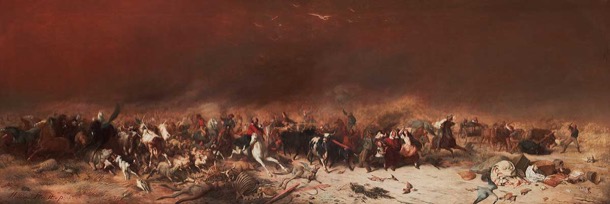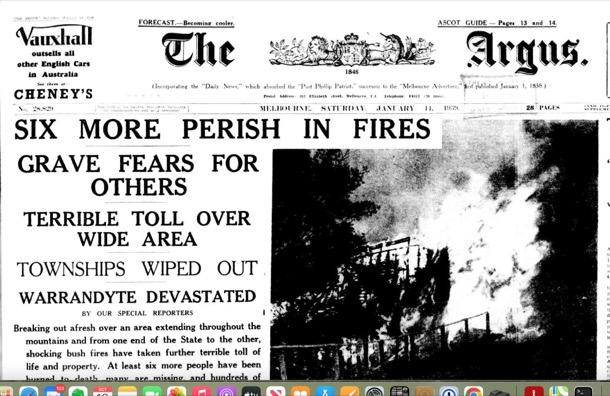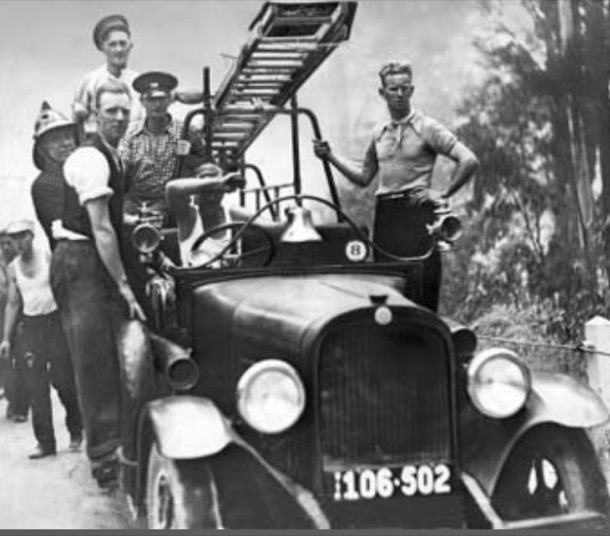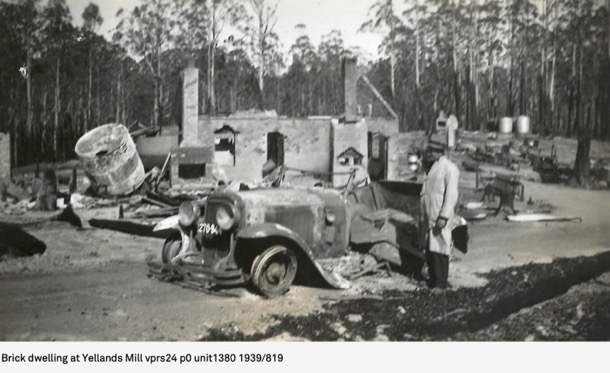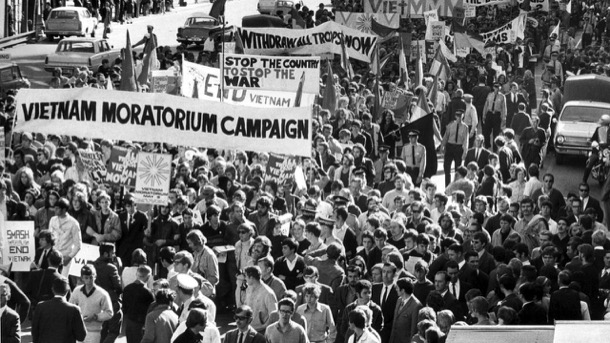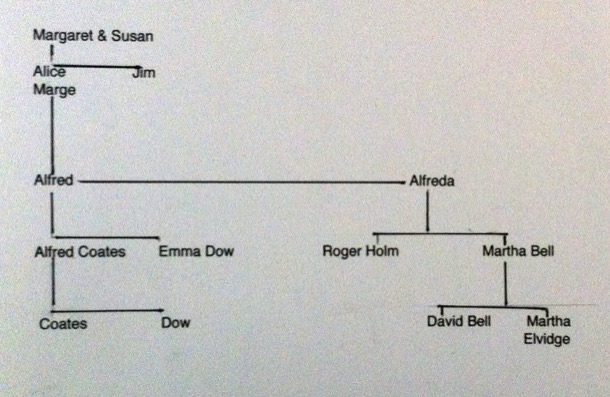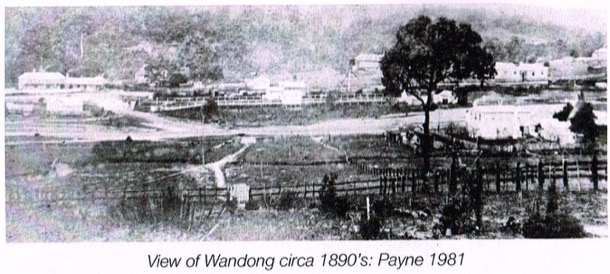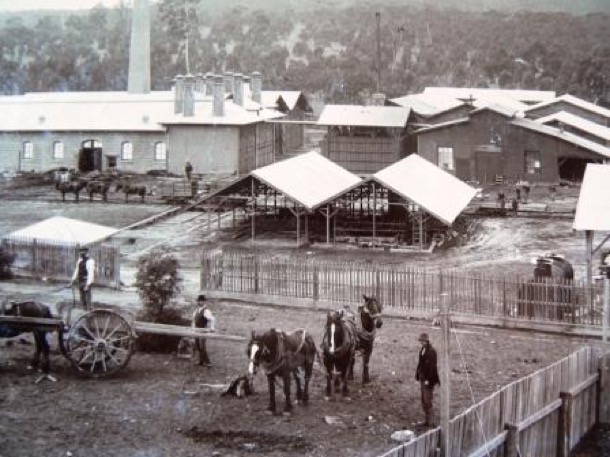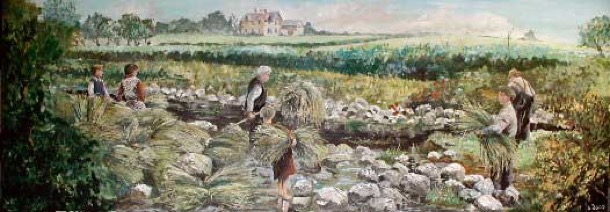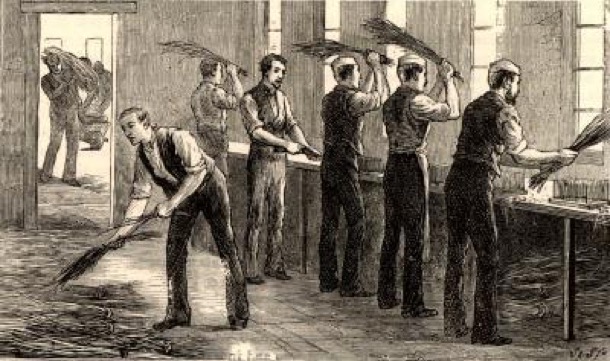Fire and Storm
MY COUNTRY By Dorothy MacKellar
‘I love a sunburnt country,
A land of sweeping plains,
Of ragged mountain ranges,
Of droughts and flooding rains.
I love her far horizons,
I love her jewel sea.
Her beauty and her terror,
The wide brown land for me.
Margaret and I learnt this iconic poem during our respective Grade 6 years and many of its lines are still etched in memory. In fact we can still recite much of it with exactly the same intonation and expression. This poem, written in 1904, captures the tenor of our post, Fire and Storm.
Fire, still very much part of our lives, has also been part of our family history.
BLACK THURSDAY 1851
The first reference to fire was in1851 with the fire known as ‘Black Thursday’.
Painting by William Strutt
This was the first catastrophic bushfire faced by white settlers in Victoria. The lead up to the fire followed what is now a familiar pattern of events. Reports at the time said that there had been wet years of lush growth followed by severe drought, leaving the bush and long grass tinder dry. Thursday the 6th of February dawned hot and windy, and the fires took off, leaving one quarter of the state black and smouldering. Our antecedents, the Bourke’s of Pakenham, were caught up in the fires in a dramatic way. Shortly before Black Thursday the Bourke’s had taken possession of Bourke’s Hotel in Pakenham. Michael Bourke remained at their selection, while Mrs Bourke was to run the hotel and Post Office.
‘On Black Thursday the whole district was ablaze. Mr Bourke was trying hard to save the station property. Water having been exhausted, milk was brought into play and ultimately the run was saved. Word was brought to him that the hotel property at Pakenham was surrounded by fire. Galloping down there, he found his wife and her children had saved themselves by crouching in the water in the bed of the creek.’
We took this photo of the exact spot, during our visit to Pakenham.
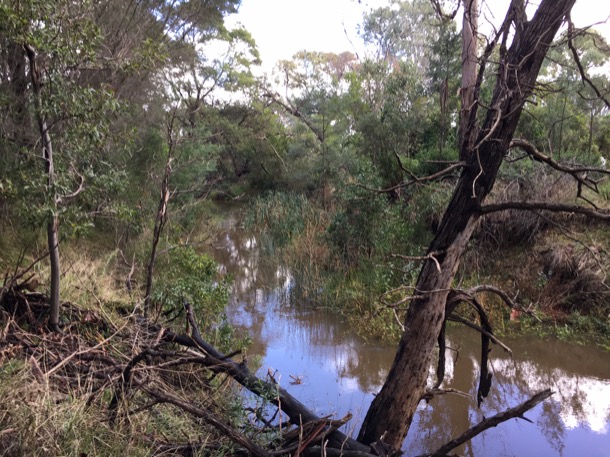
BACCHUS MARSH FIRE 1928
From an article in ‘The Argus' Thurs 12th July 1928
"FIRE AT BACCHUS MARSH.THREE SHOPS DESTROYED"
This was a report on the fire suffered by our grand parents, Alf and Alfreda, in which they lost almost everything, but escaped with their lives. We heard dramatic stories of this fire in childhood and is told below by Marge and Alice on the tape they made in 1990.
The hardware shop was their business, and they had gone out on their own, in an already a difficult time of their lives. Aunty Bert was staying with them to help out, as was her role in the family, as the unmarried sister. Auntie Bert, Alf and Alfreda would have been in their early thirties,Alice was five and Marge three years older. Thank goodness Bert was there as she seems to have had a cool head and took action to get everyone out as the fire took hold.
Marge and Alice’s recollection is fairly accurate, as the newspaper report comments on the strong North wind and the poor water pressure that hampered the fire fighting.
The Argus reports that at one stage,
…. the premises of Mr. G. H. Anderson were threatened , but this danger passed, with a change in the direction of the wind, A good portion of the stocks of Messrs. McLaren and Coates was saved, but considerable damage was done to Mr. Phillip’s stock. It is understood that all buildings and stock, except that of Mr. McLaren, were insured.
At half-past 7 o'clock, in the morning the fire was under control, and all that was left of three of the shops were the walls.’
Mr McLaren may have been uninsured but Alf was definitely not, as he had been unable to pay the insurance. They lost nearly everything.
We had wondered about Alice’s comment about Auntie Bert’s friend Nell Pearce, whose family took them all in after the fire, and yes it was a large and impressive brick house, still standing today: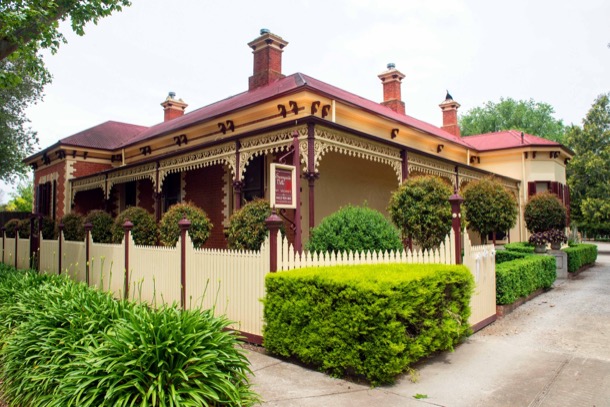
As Alice states the Pearces were an influential family in the town. They had been an early pioneering family in the area. They built and established the General Store that presumably was very profitable, supplying the miners on the way to the Goldfields as well as the local community. The family then went into farming and other small businesses, and were influential in civic affairs.
Auntie Bert maintained a lifelong friendship with Nell, and neither of them married. I remember Nell Pearce being a name mentioned in conversation and I have a vague recollection of her as an imposing figure. I also remember her at Auntie Bert’ s sewing rooms in Camberwell. She was probably there for a fitting. Little did we know the history behind that friendship.
After cleaning up and sorting our their affairs Alf and Alfreda, the girls and presumably Auntie Bert left Bacchus Marsh and stayed with Grandpa and Grandma Holm in Surrey Hills. Alf then got a job in Croydon as manager of the hardware shop, where they spent many happy years.
BLACK FRIDAY 1939
After the 1851 fires, bush fires occurred in many parts of the State with predictable monotony. The next major statewide fire was in 1939, once again after a prolonged drought. High temperatures and strong northerly winds fanned separate fires that eventually combined and created a massive fire front that swept mainly over the mountain country in the northeast of Victoria, and along the coast in the southwest.
Lilydale Brigade 1939.
Source - CFA Website
More than two million hectares were burnt in the 1939 fires.They lasted for a week. Many, unable to be controlled, were left to burn out.
Yellands Mill, where 15 men died:
The extensive damage to over two million hectares of farmland and forest, not to mention the loss of livestock and lives, prompted a Royal Commission. They were tasked with examining the causes of the fire and making recommendations for future management.
The Royal Commission’s specific recommendation was that the various Bush Brigades, and Country Fire Brigades be amalgamated to form a single organisation to fight fire on private land outside the Metropolitan Area. The Forest Commission was responsible for fire on public land and the Metropolitan Fire Brigade was responsible for fire in the Metropolitan Area. Instead of a myriad of uncoordinated small brigades these three organisations were responsible for fighting fires in Victoria.
EARLY BUSHFIRE EXPERIENCE - MARGARET
My first memory of wildfire is of a fire on the empty block next door. The vegetation was sparse: weeds and gorse, with patches of bare clay.
We think it was around 1955. Sue doesn’t remember it, and was probably at school. But I have a clear memory and so I was probably at least four. The image in my mind is of mum, armed with a hessian bag, beating flames. Hessian is a coarse, rough brown fabric made from jute, widely used for packaging. We had a supply of hessian bags, saved from buying bulk chook food. Mum was not a “bush woman” in the Henry Lawson image, but she would have seen this form of fire fighting, and she apparently felt able to take it on. 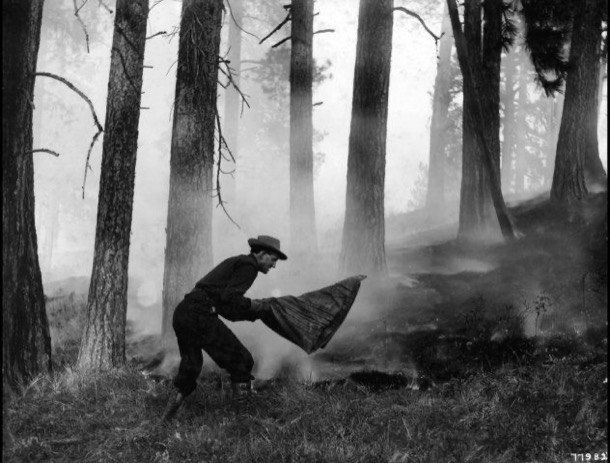
Fire fighting with a hessian bag.
I don’t remember bush fires being a big part of my life as a child, until I was eleven, in 1962. That year was a big bushfire year in Melbourne’s eastern suburbs: 32 people died and 450 houses were lost. Areas affected included Mitcham, less than ten kilometres away from our place. We were never in danger in suburban Box Hill South, but there would have been a red glow in the sky, and the vivid memory I have of burning gum leaves falling in the back yard, is probably from this fire.
In 1979, I moved to the Dandenong Ranges, where the CFA had much more of a presence, and bushfire awareness was part of everyday life over Summer.
In those first few years, there was still on old dugout just over the road in the forest. It had a wooden sign “Dugout” and what looked like a large wombat hole. A closer look revealed a heavy grey army blanket hanging over the entrance. During a fire, this would be kept wet. Inside was a rounded cave, with earthen floor, ceiling and walls. It would have held a maximum of six adults. There was a metal bucket and a pile of musty grey wooden blankets. I guess it might keep you safe while a canopy fire raced overhead, but I wouldn’t want to rely on it.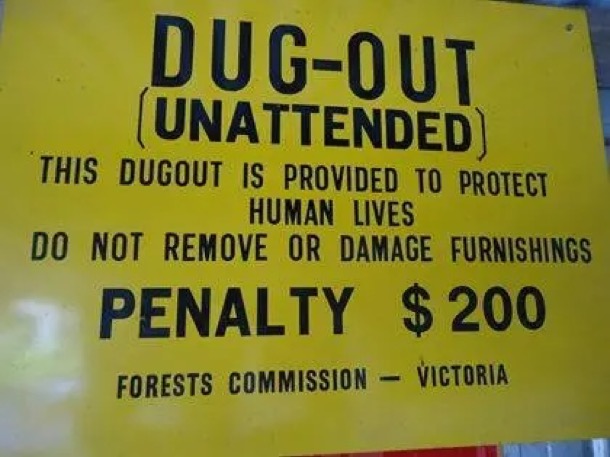
The CFA were, and still are, omnipresent. On weekends they collect donations at major intersections. On Good Friday, and in the week before Christmas, they drive through the streets, playing piped music and rattling collection tins. Their sirens regularly echo through the Hills. We can hear the Belgrave, Upwey and Kallista sirens from our place, and sometimes all three will go off. In the past, the siren was used to call in the volunteers, and on a set night of the week, on CFA practice night, they would test the siren at a set time. We like that the sirens are still used, not so much as a specific warning, but as part of our aural landscape.
Nowadays, when we hear a siren, we go straight to the Victorian Emergency app, to check what has happened. Often it’s a house fire, a car accident, a small bush fire. During the Summer months we are more attuned to the sound. Our practice has long been to evacuate on days of dangerous fire weather.
BLAIRGOWRIE FIRE 1980 - SUE
My only experience of fire first hand, was in 1980 at Janey’s house at Blairgowrie. We had all just sat down to lunch. Anna was nearly three and I was pregnant with Thomas. Everything was tinder dry, as it was January and we were in the middle of the 1979-1983 Eastern Australian Drought.
Halfway through lunch there were loud knocks at the door, and a panicking young man asked us for a hose, as he has seen a small fire beginning to build on the Spray Point Road, just fifty metres from the house. Jono and Janey raced down to investigate, but realised that they had not a chance of stopping the fire. It was spreading quickly, fanned by a strong north wind. This was a stroke of luck as this meant it was spreading away from us and towards the beach. We called the CFA who responded promptly, parking several fire trucks at the hydrant on the nature strip.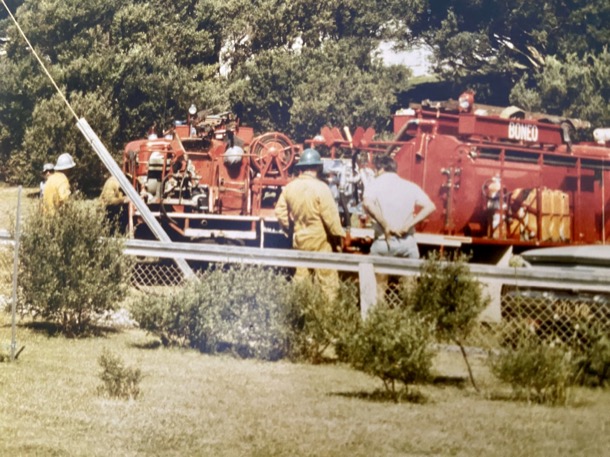
We were told to block the downpipes with oranges, fill the gutters with water, and shelter inside. The fire was brought under control fairly quickly but not before six hectares of the National Park was burnt.
It would have been a different story if the wind had changed and pushed the fire towards Janey’s house and of course all the other houses.
Local newspapers at the time reported on the fire and issued warnings and advice to residents and holiday makers for the rest of the holiday season that was only just beginning.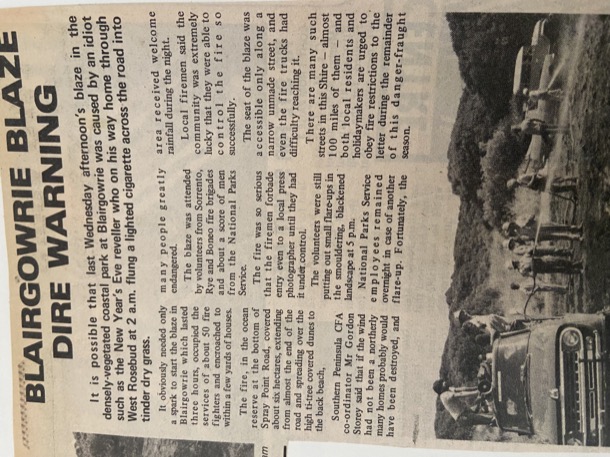
ASH WEDNESDAY
SUE
On Ash Wednesday I was at home with Thomas, as Anna had just started school. Thomas was happily playing with water in the shade of our pergola, as it was a very hot day. A nasty north wind intensified as the day wore on and many fires started across Victoria. I was listening to the ABC afternoon show hosted by Tony Delroy, who, as fires broke out, was reporting the outbreaks in real time. He also took many calls from people desperate for information. There were no centralised communications hub, warning system, or, of course, mobile phones. As the fires continued to burn during the evening and that night, the radio was the only source of state wide information. The 3LO radio hosts worked on a roster system to get the information out.
Since its inception the ABC had been responsible for emergency broadcasting, but only on the news bulletins.. In 1997 Ian Mannix was appointed as Program Director for Local Radio Victoria. He changed the nature of emergency broadcasting during the 1997 bush fire in the Dandenong Ranges. The fires burnt for days, three people died and forty homes were destroyed. Mannix asked the CFA for advice on what to say to to listeners ‘who were confronted with flames.’…Interestingly, the CFA had no experience of giving warnings and had never written a warning for people at risk.
Mannix went ahead and took the lead in creating the ABC’s approach to emergency broadcasting. He developed guidelines that included warnings at set intervals, including bush fire alerts for low level fires and urgent threat warnings for more serious fires. The system used in Victoria was expanded nationally after Black Saturday in 2009. Further recommendations were made by the Black Saturday Royal Commission that future refined and expanded the warning systems to television and commercial radio.
From this pioneering work by Ian Mannix, we now have an Australia wide warning system, and broadcasting training and guidelines in each state.
Ian Mannix oversaw the development and implementation of these systems and deservedly received the Australian Public Service Medal in 2012.
MARGARET
The first actual fire we had to deal with in Belgrave was the 1983 Ash Wednesday.
The name “Ash Wednesday” is nothing to do with ash from bushfires. It’s a historical/religious reference. It happens every year, and it marks the beginning of Lent, leading up to Easter, in lots of Christian denominations. It follows Shrove Tuesday, Mardi Gras … the last day of feasting before the deprivations of Lent. The ‘ash’ is sprinkled onto heads or swiped across foreheads as part of the Ash Wednesday service.
1982 had had a very droughty Winter, Spring and Summer. The little creek that runs through the forest over the road had almost stopped, and underfoot the leaves crackled.
The 1983 Melbourne dust storm, when 50,000 tonnes of Mallee topsoil turned the sky dark brown across the city, happened in early February. For me, it hit as I was crossing Burwood Highway on my way to the Ferntree Gully hotel, for an after school cool drink. The dust cloud was over 300 metres high and 500 kilometres long, and darkened the sky for an hour. It’s one of those iconic events where everyone can tell you where they were when it hit.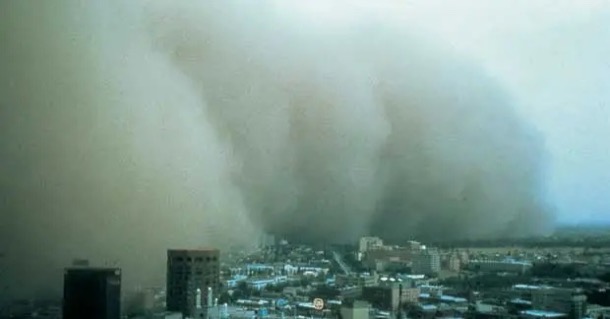
Image credit: Katsuhiro Abe/BOM
There were many fires that Summer. The CFA across Victoria attended nearly 3,200 fires. Wednesday February 16th was particularly hot and windy.
That morning I had woken feeling nauseous and weak. I rang in sick, and went back to bed. Within a few weeks, I would find out that this had been the beginning of morning sickness. Michael was born that October.
Later in the day I had a phone call from a friend who lived locally, suggesting I might consider leaving, as he had heard there was a fire in Belgrave Heights. Outside was stifling. My neighbour was packing her car but she was expecting to wait and see. I don’t remember having any sense of danger, though, later, we learnt that it was only the late afternoon wind change that stopped the fire from sweeping through Belgrave township and on to our place.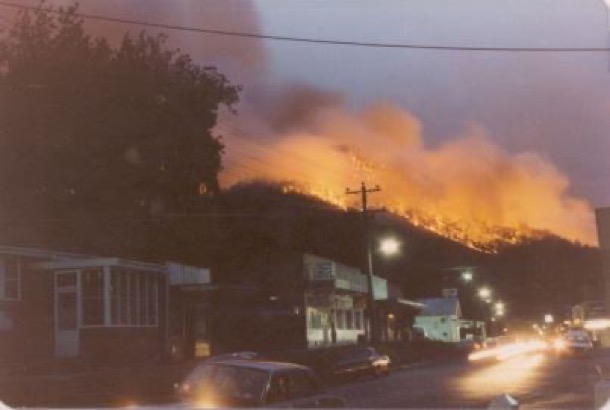
Photo: Tonia Van der Dungen. Christmas Hills CFA
Wind changes during bush fires dramatically widen the fire front, and this one swept through Belgrave South and on to Cockatoo and Upper Beaconsfield.
I don’t remember this, but apparently Ian and Lois were visiting me that day. Lois was pregnant with Sam who was born that winter. Ian speaks of driving home in the afternoon, and taking the sudden decision to drive straight on through Belgrave, rather than the more logical route through to Belgrave South. This would have been exactly the time of day when the fire swept through across the road they would have been on.
Later there were many stories, horrifying and heroic. In Cockatoo, 300 people sheltered during the night in the kindergarten, as a handful of local men kept the flames and embers at bay, saving many lives.
Across Victoria, 75 people died, more than 200,00 hectares were burnt and 2000 homes and buildings were damaged.
Friends from the suburbs rang to check that I was ok. Our little patch of the Dandenongs was untouched, but one didn’t have to drive very far to see the black horror.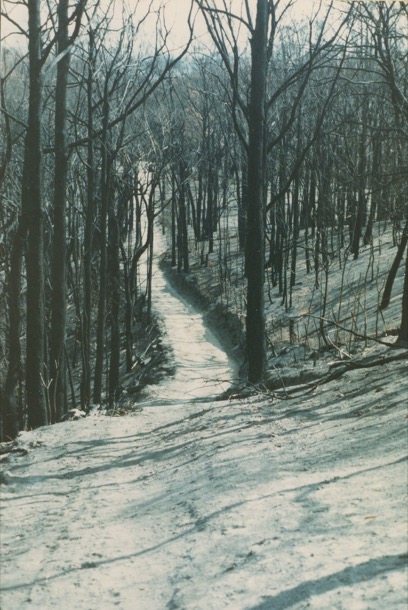
Photo: Critchley Parker Junior Reserve. Upper Beaconsfield CFA
Ten years later, I began teaching at Monbulk College, and some of our students were still affected by their experiences in 1983. My friend and colleague Sarah had her Year 8 English class make a booklet marking the ten year anniversary. Everyone had stories, which the students typed up and put together. It remains an important part of the history of Dandenong Ranges, and other affected parts of Victoria.
The tragic Ash Wednesday fires were like those of 1939 Black Friday in intensity, if not in range. They confronted the modern firefighting community with the limits of its capacity and technology. Among the 75 dead, 17 firefighters died that day, some of them next to their well equipped tankers on a forest road in Upper Beaconsfield, when the wind changed and the firestorm swept over them. Changes in firefighting strategies and philosophies were inevitable. The community needed to be better informed and more involved. This is certainly my experience. I was so naive and ignorant, compared to what we expect from Hills people nowadays! There was a huge Royal Commission.
It seemed, as the Commission heard people’s Ash Wednesday stories, that the most dangerous situations people faced were from hurried departures. People died in their cars, not their homes. But the CFA could not guarantee to be there during huge bush fires, protecting every home.
And then there were stories of people actively defending their homes from ember attacks, and saving them. “People save houses. Houses save people.” was the mantra.
The “stay or go” policy began to be developed. As the professionalisation of firefighting, and the ‘Science’ of fire behaviour developed, ordinary people’s anecdotes were often disregarded as over hyped and hysterical.
There was a huge campaign to teach the population about how to prepare their homes, and defend them. Because it was so centralised, the people who lived on the edges of grasslands and those, like us, in what nowadays we call the “flame zone”, were given the same advice. The “go” part of “stay or go” felt like an afterthought for people who were not able bodied. I remember some of our neighbours’ plans were that the men and older boys would “stay” and the women and little children would “go”.
In 1987 the very first General Achievement Test had as one of its tasks information about how to prepare a home for bushfire. It was clearly in the zeitgeist.
My personal experience of this policy is encapsulated by a CFA Fireguard group meeting, in the years leading up to 2010, that we attended on our neighbour’s verandah. The CFA man explained patiently about how bushfires behave, and how we should be preparing our houses, so that we could defend them. The expectation was clearly that we and our neighbours would stay, in the case of a bushfire, and, with mops and buckets of water, we would put out any embers that threatened out house. We pointed to the towering ash forest, metres from our house, and told him we didn’t think our house would be defendable. He was not impressed.
Throughout the Millennial drought, from 1997 to 2009, during the most severe summers, we kept a trailer full of things at Chris’s parents’ place, and had a very clear plan. We evacuated quite a number of times, staying in their spare room. The plan was to insure fully, and simply not to be there during dangerous times. The local schools built fire refuges, and the CFA kept on with its “stay and defend” message. Water saving advice was everywhere. Like many others, we set up a grey water system to water our garden.
BLACK SATURDAY - MARGARET
And then came the summer of 2008-9. It had been particularly dry and hot. This was the summer when tree fern fronds were scorched, lawns died and record high temperatures were broken day after day. The forecast for the first week of February looked horrendous in advance, with temperatures of 48 degrees forecast, and Chris and I decided to take ourselves camping by the Thurra river, and wait it out. I was glad to be retired by then!
We followed the news of Black Saturday, on the radio, and, once the cool change hit, we packed up and drove out along the Thurra Road, as news of the death toll mounted. Along the Princes Highway, we saw fire fighters’ camp sites with row after row of little tents. The air was smokey, and through the Latrobe Valley we drove through a blackened landscape. At home, the garden was scorched and everything still crackled underfoot.
Back with television coverage, we watched interviews with people who had miraculously survived, saw footage of people’s fire refuges that had been easily breached, and heard the stories of person after person, traumatised by their unsuccessful attempts to defend their homes. 173 people had died, 120 of them in the Kinglake area. More than 450 hectares had burned and 3500 buildings, 200 of them houses, had been destroyed.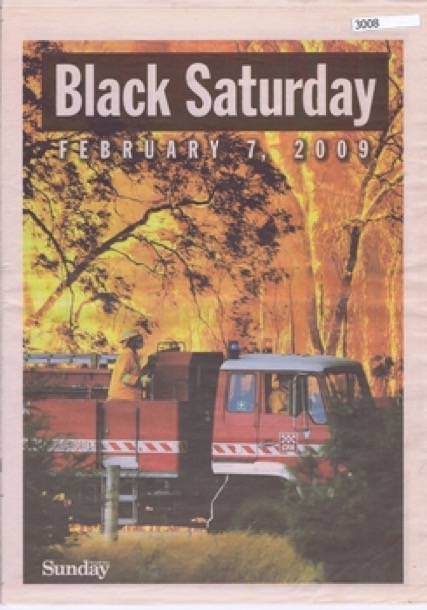
Herald-Sun
That cool change was not the end of the 2009 fire season. We evacuated a number of times that February. One day, a fire bug lit a fire just up the hill from us. I was sitting outside, and heard the crackle as flames licked up a nearby gum tree. Chris was walking in the forest. As I drove down to the Belgrave carpark, he was walking quickly back down through the forest, having seen the smoke. When he met a wall of flames, he backtracked hastily, headed toward the road, and hitched a ride with a stranger to near home. The wind was blowing the danger away from our place. I have been mocked mercilessly for my paper post it note on the door telling him I’d gone to the Belgrave car park, but at least he knew that I was out of danger.
In the car park, a gaggle of us watched the Elvis fire bombing helicopters head up the hill, and cheered, and very soon the whole drama was over.
2009 marked the end of the Millennial drought years. Summers since then have been cooler and wetter. But the legacy has been an obsession with rainfall figures, forecasts and climate outlooks.
Our local community facebook page has a member who is a forecaster with the Bureau of Meteorology, who posts every time there is a weather anomaly. It is clear from the responses to him, that we are not alone in our anxiety about rainfall.
THE BIG STORM - MARGARET
It was winter, 2021. There had been yet another Covid lockdown, this one lasting two weeks, finishing on June 10th. Life quickly went back to normal for most people in Melbourne.
But for us in the Dandenongs, the evening of June 9th, and the next morning, brought a massive windstorm which brought down huge swathes of trees, many across roads and onto 112 houses. The wind came at 120kph, but it came from an unusual direction, and our shallow rooted mountain trees were largely untested from that direction. They fell, roots and all, in their hundreds.
Even though the power went off immediately, and all the mobile towers were out, there were 9,500 calls for help logged by the SES. People were trapped in their houses, and many streets, including Michael and Katherine’s were blocked off. There was no way of communicating, in or out, for many days.
My most vivid memory of the storm comes from early on the morning of the tenth. Chris was standing with a view to the north of the forest out the window. His eyes widened, and yet another a great crash came from the forest. He had watched a two hundred foot tall mountain ash eucalypt gracefully fall sideways, taking down another tree of similar size, which in turn took out another one. Like enormous dominos, the three of them had joined the huge pile of previous victims on the forest floor. Later on we stood on the road, looking down where they had fallen and counted thirteen giant trees lying in a messy tangle.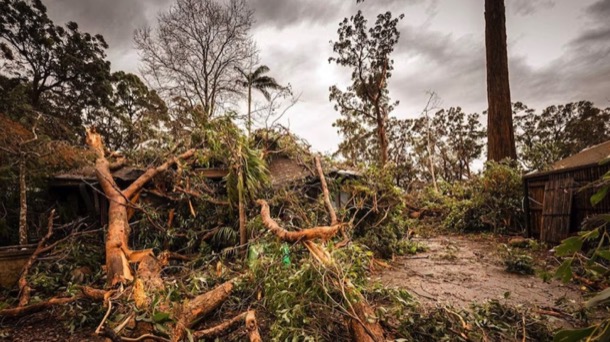
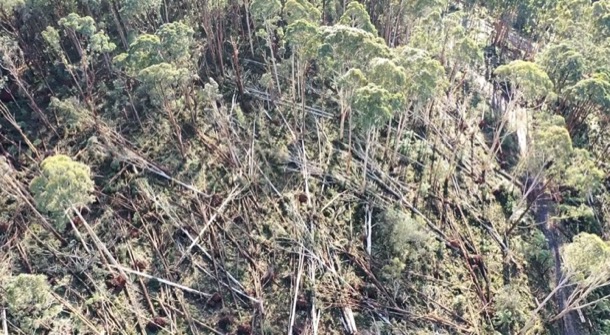
Elsewhere in the Hills, this carnage had been repeated in town after town. We lucky ones who still had homes, watched with dismay as the power company’s estimates of power restoration stretched out beyond a week. Eventually we were able to drive out. It was a weird feeling to drive down onto the flat and find life going on as normal. For us the feeling was very much as if we were still in lockdown. On the Monday evening, I went to choir rehearsal in Ferntree Gully, blinking in the unaccustomed bright lights. Many of us Hills residents had brought items to be recharged during the evening. At end of the night we drove back up into the darkened Hills.
At home, we went into camping mode. There was no hot water, but we had plenty of fire wood, and our very effective wood heater. We cooked with gas and our little portable gas fridge kept our essentials cold. I took to having my bucket bath in the afternoon, when it wasn’t quite so cold in the bathroom. It was ten days before our power came back on, on June 20th.
The reprieve from lockdown lasted only a month. By July 16, Melbourne was back into working from home, home schooling, and leaving home only for essential purposes.
Hair
This post therefore is about hairstyles, but we have allowed ourselves a much broader scope.
ALFRED JOHN COATES
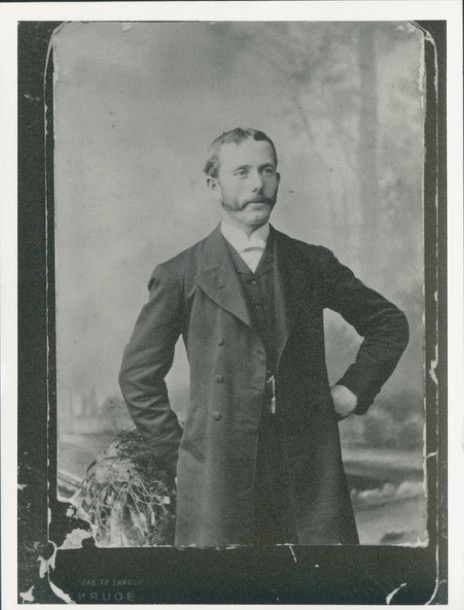
Alfred John Coates, born in 1857, was probably in his late twenties when this photo was taken. He was our maternal great grandfather and was a Methodist Pastor for most of his working life. In this photograph Alfred is a young man in prime of life, dressed in formal dress and sporting the fashion of the day: mutton chop whiskers, carefully manicured to join artfully with the moustache. A man of destiny, the misty ‘bush’ behind him, he stands erect, eyes on the future. At this time Alfred was apparently a boiler maker in Ballarat.
Men’s facial hair trends were changing rapidly in the late 1800s. Long beards were out and clean chins and cheeks and a well-manicured moustache were in. To achieve this look men would need to go to a barber two to three times a week or shave themselves.
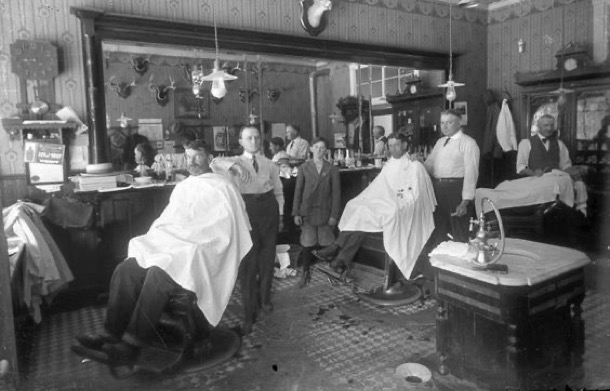
Shaving oneself may have been a financial necessity at times but it could also be a dangerous procedure. Shaving was done with a straight steel razor that required care and expertise, not only in the act of shaving the gentleman, but also in the care of the blade. To keep it sharp, the blade was rubbed against a leather or canvas strap before each new shave. As well as the blade, shaving soap, shaving brushes, combs, oils and wax were essential items to achieve the desired effect.
Having a photograph taken in a studio was a special occasion and a relatively expensive exercise. One can imagine that Alfred may have had a trip to the barber to ensure that he looked his best.
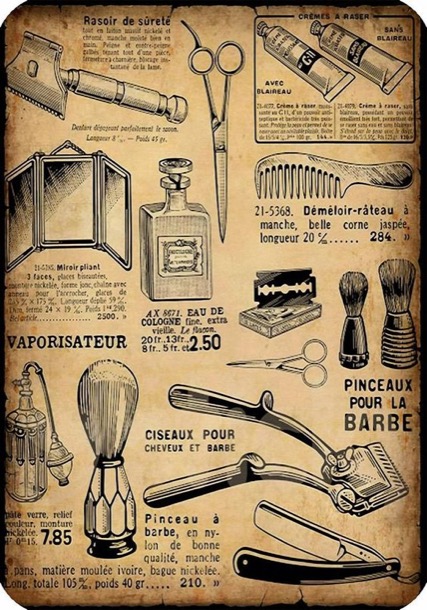
Safety steel razor blades that made shaving much easier were not invented until 1895 by an American business man with French heritage.
King C. Gillette invented a low cost blade that was easily replaceable and gave men safety and the freedom to achieve the look desired themselves.
EMMA ELIZABETH DAU
Alfred married Emma Elizabeth Dau in 1888. He was thirty-two and she was twenty Maybe this photo was taken at this time:
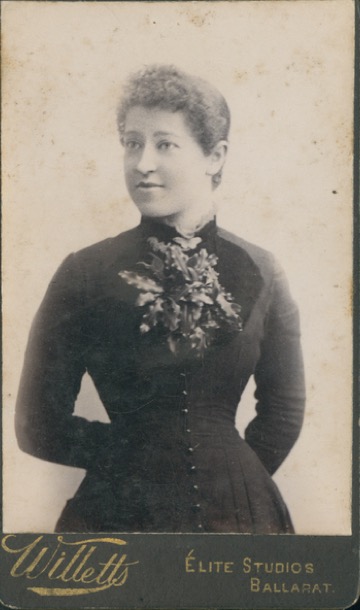
Emma is dressed in the style of the day, hourglass figure no doubt with a corseted waist as she gazes into her future with a determined tilt of her chin. Her hair is tightly curled at the front and pulled back into either a bun or pinned up plait.
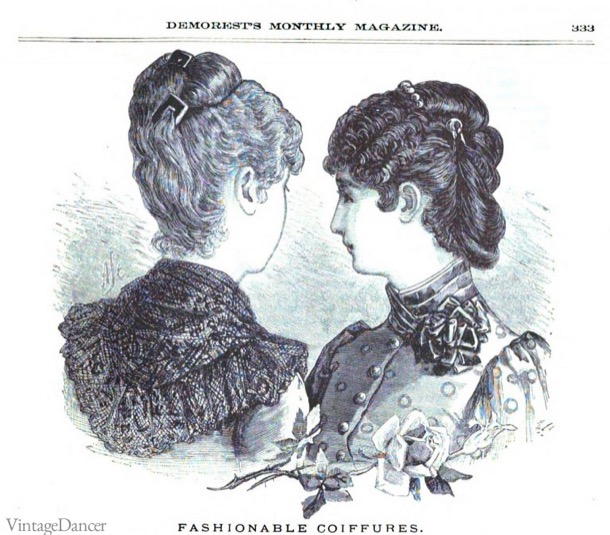
Unlike the men who had barbers to attend to their needs, there don’t appear to be many ladies' hairdressers. Women had many home implements and potions and maybe sisters and mothers helped each other with their hair.
Young Emma’s tight curls may have been created with curling irons. A curling iron consisted of a metal rod that was held over a flame or burning alcohol to heat it, before wrapping the hair around it. Hey presto, curls!
Later in life, Emma wore her hair in a more relaxed style, loosely pulled back from her face and pinned up into a bun at the back:
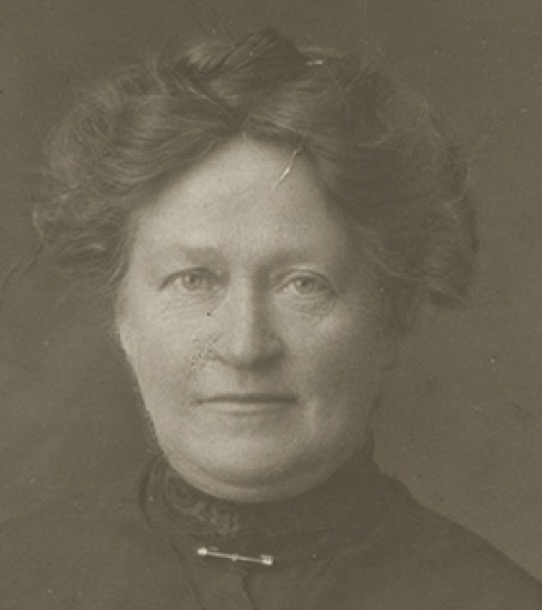
When this photo was taken, the height of fashion for women was to wear their hair with more volume at the sides. This was created by using clumps of hair leftover in combs and brushes, to pad out the sides. Emma would not have gone to these lengths in later life, but on her dressing table she would have had a brush, comb, hand mirror and china box, with a lid for the collection of hair caught in brushes or combs. We can remember our grandmother, Alfreda, also having these items on her dressing table. She wore her hair long all her life. During the day it was loosely tied back in a bun, brushed out at night, and the ‘ratts’ collected from the brush and placed in the china box. She then plaited her hair into a loose, single long plait and was ready for bed.
NINE DAU SISTERS
Emma Coates, was born Emma Dau. She was one of seventeen. The first nine of these were girls.
We have three amazing little photos of some of the Dau children. We have spent a long time staring at these images, noticing little details, wondering about the lives of these nine little girls.
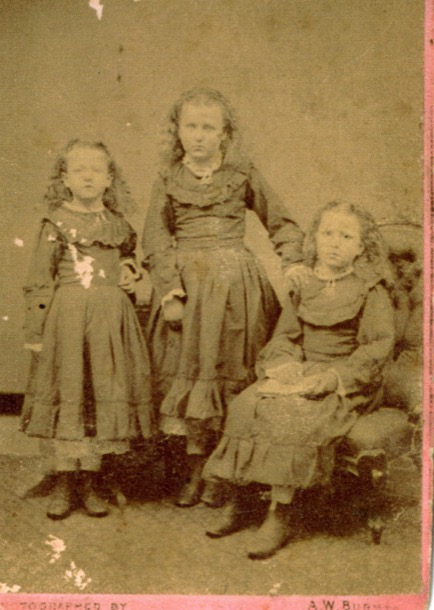
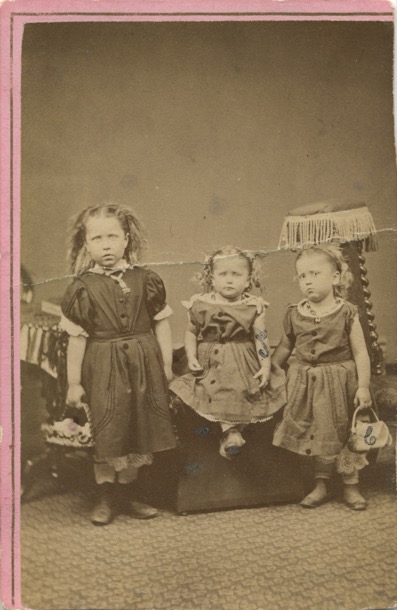

The first question we had was, "Were the three photos taken at the same time?". There is such a family resemblance, we weren’t sure at first whether they were different people in the three photos. The carpet gives away that they were taken in the same studio. On the back of one of the playing card sized photos, we see “one shilling per copy”. For context, at that time, a shilling was more than a day’s wage for a working man.
It seems most likely that the three photos were taken on the same day, and they are the nine oldest children, all daughters, of Joachim and Martha Dau, our great, great grandparents.
The photo of the three eldest has writing on the back:
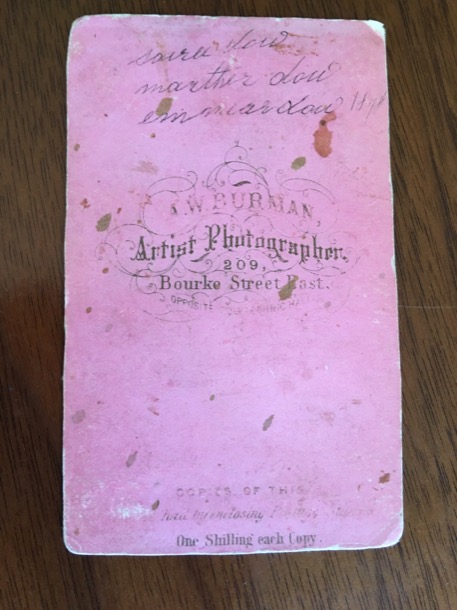
The fact that Martha is misspelt as “marther”, and that no capital letters are used, might be a clue. It was not our mother Alice, nor her parents. None of them would have made such a basic spelling error! The surname is listed as “Dow”.
If those names are correct, then these are the three eldest Dau children. Standing is Sarah, the eldest. the other two are Martha, known as Mishi, and Emma, our great grandmother.
Thanks to the Wandong Historical group, we have the details of nearly all the Dau children.
The next three girls are Bella, Jane and Sophia, followed by Alice, and two others, possibly Annie and Nance, although some sources have Annie and Nance as the same person.
There is no date on these photos, but there are nine girls. The nine first Dau children, all girls were born between 1866 and about 1878. This puts the date of the photos at about 1880, with Sarah, the eldest, aged 14 and the youngest aged 2.
The girls’ father, Joachim, had spelt his surname, Dau. We don’t know the exact date they changed it to Dow, but Frederick enlisted to fight in the Boer War as Dow in 1901, and Arthur, who became a professional soldier, changed his name by deed poll to Dow. The same anti German sentiment that caused the British Royals to change their surname to Windsor from Saax Coburg was no doubt responsible. And yet the Dau spelling persists alongside the Dow spelling, right up until 1929, when Sarah, the eldest wrote about her childhood. Our mother and aunt did not even know about the Dau spelling.
The photographer is listed on the back as Burman, 209 Bourke St Melbourne. The building is still there. This is what it looks like today:
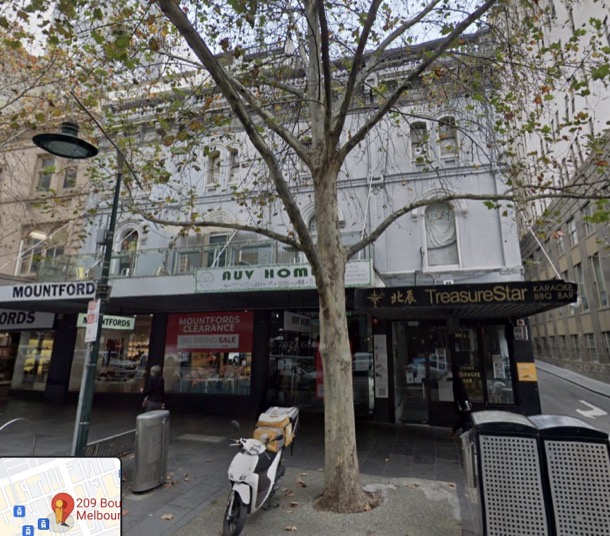
There are a number of old photos by Burman available on line, with that tell-tale carpet visible in some. This one, “Portrait of a Lady”, which uses the same chair as two of our photos, is from C1865.
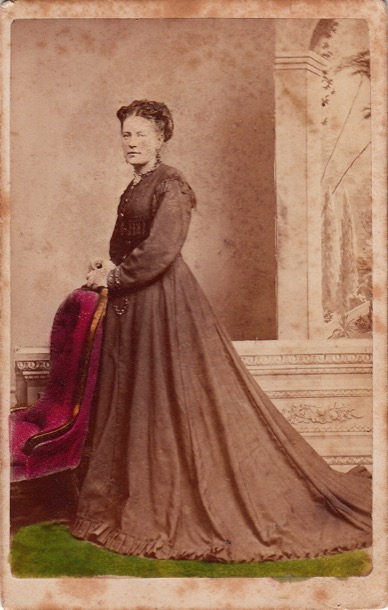
We picture the little farm girls, in their new dresses, in the big noisy city. They would have come on the train, to Flinders Street from Wallan, and walked the three city blocks to the studio.
The city streets would have looked like this:
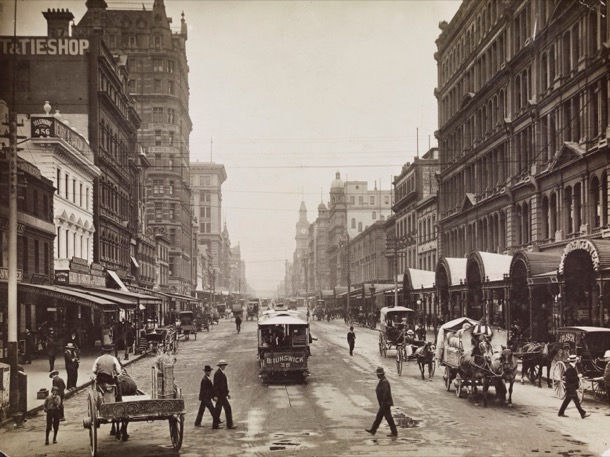
Their hair would had been in rags overnight. The curls in Sarah, Martha and Emma’s hair have been successful; the others less so. All of them have a ribbon holding their hair back from their face.
The dresses are interesting. The same fabric and pattern seems to have been used for the three eldest girls. Who made them? The next three also have a similar style. All have sturdy boots and frilly pantaloons. These outfits would have been worn to church on Sundays. Did they wear them for the train journey, or change at the studio?
The only other girl, born in 1887, preceded and followed by the seven boys, was Ethel. She wrote diary entries, still held by the Wandong Historical group. Ethel wrote about the boots, which are such a feature of these little girls’ photos. “the rough track across the paddocks and hills, two miles to the little school at Wandong. In wintertime, we had to cross many flooded gullies. We wore strong boots and I was often peeved, as I compared my strong shoes with the dainty ones worn by the other girls at school.”
It was quite an expense to provide boots for so many children.
Our appetite for finding out more about this family is well and truly whetted. We plan further exploration, including an excursion to Wandong.
THREE HOLM SISTERS
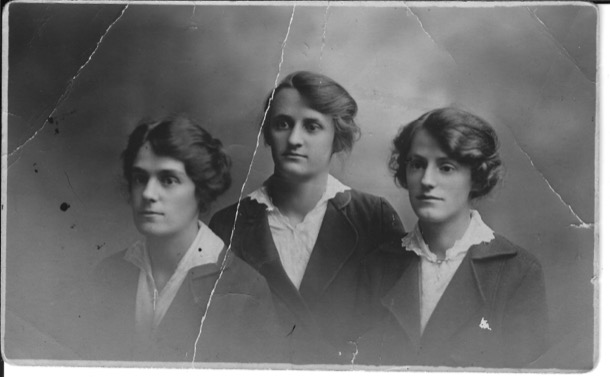
These three young women, probably photographed just before the first world war are (left to right) Alfreda, Beatrice and Berta Holm. Alfreda, our maternal grandmother, was the oldest of the three, perhaps just twenty at the time. The three sisters have their long hair swept back in gentle waves, to a loose bun or twist at the back.
We wonder whether they did the white work on their shirts? We know that Beatrice and Berta spent time working in Finders Lane, doing the white embroidery known at the time as “white work”. So much we can only guess at.
They all gaze into the distance: Alfreda with a determined steely gaze, Beat with a quizzical half smile and Bert’s beautiful eyes not quite hiding her vulnerability. We can only guess, as they gaze into a future where world war is imminent.
Alfreda wore her hair long all her life. We can remember her brushing her hair at night and putting it into a long plait.
TWO COATES SISTERS
It’s hard to be a younger sister, but our mother Alice, was the fairly plain younger sister of an extraordinary beauty.
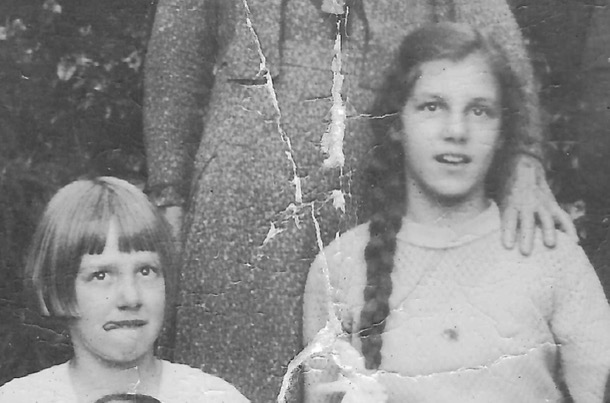
She didn’t have to deal with social media, but, when she was growing up in the 1930s, feminine beauty was important for girls.
Alice was an intelligent and able scholar, and, thank goodness, this was highly valued in her family. Her mother, Alfreda, had made sacrifices and fought for her own education. For their later secondary school, the girls were sent, at huge expense, to a city based secondary school, all the way from Croydon.
Only the wealthiest or most determined families sent their girls to school, after the age of fourteen. At McRobinson Girls’ High School, Marge and Alice were taught by, and shared classes with, the very brightest and best: future women scientists, lawyers and doctors, who would pave the way for our own generation.
But, from her school reports, we see that, while she held her own on the whole, Alice was not exceptional in that auspicious company. And she was crippled, probably her whole life, by a sense of inferiority.
And it is in their respective hair cuts from that time, that we see how the contrast between the two girls was accentuated.
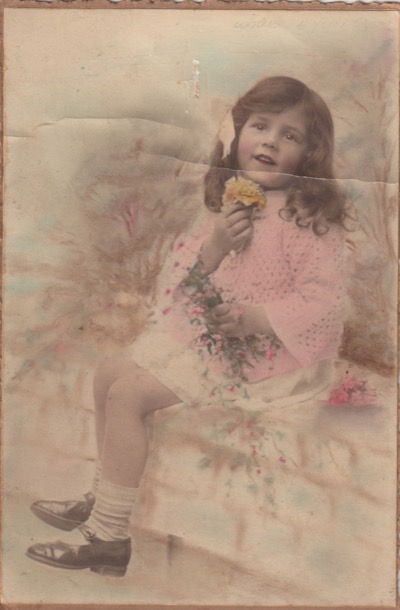
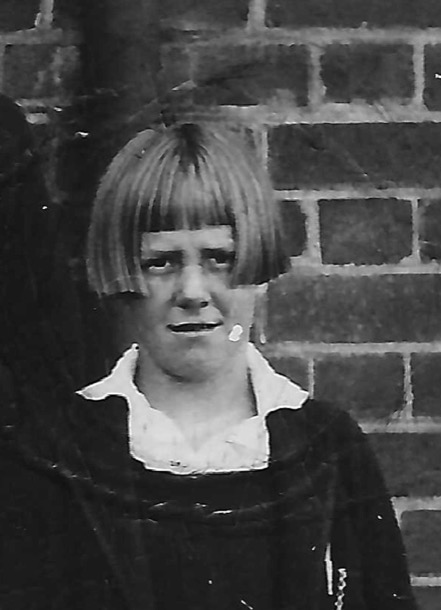
When I stare at those grainy old photos, at Marge’s lush locks, and Alice’s blunt, unfashionable short bob, and straight fringe, I cannot help but ask “Why?”. Why did Alfreda allow her younger daughter to wear such an unflattering style. Why was the difference in feminine beauty accentuated and underlined so prominently by the two hairstyles? How might Alice’s life have been different, had she been encouraged to make the most of her looks, as well as her brains?
Even as they began working life, both at Maribyrnong Munitions Factory, in 1939, the difference remained. Here Marge is on the far right, and Alice on the far left. Alice is nineteen and Marge twenty-one. But the choice of hairstyle reflects very different attitudes about their appearance:
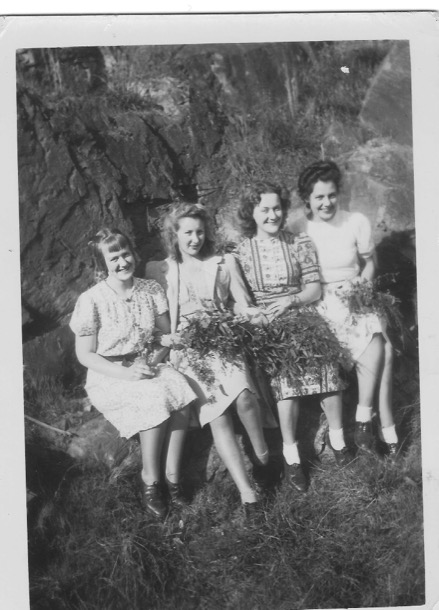
THE VICTORY ROLL
These two studio photographs of Marge are portraits of a beautiful young woman, but what does the hair tell us?
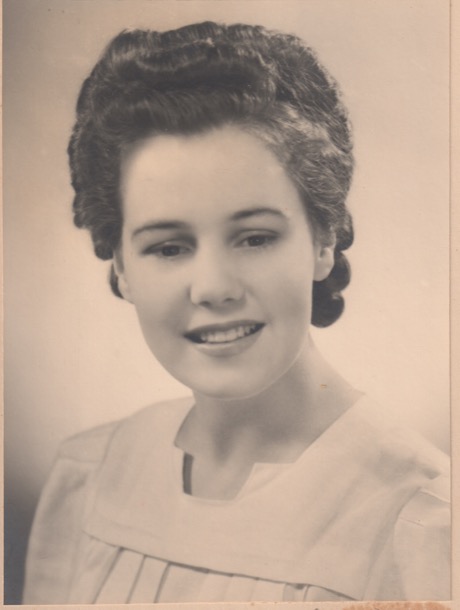
Here, a younger Marge still has very long hair, worn up now, as befitted a young woman who was no longer a child. Pretty curls and barrel curls were the look, and Marge had beautiful, wavy, very cooperative hair and was able to construct ‘the look’ very successfully.
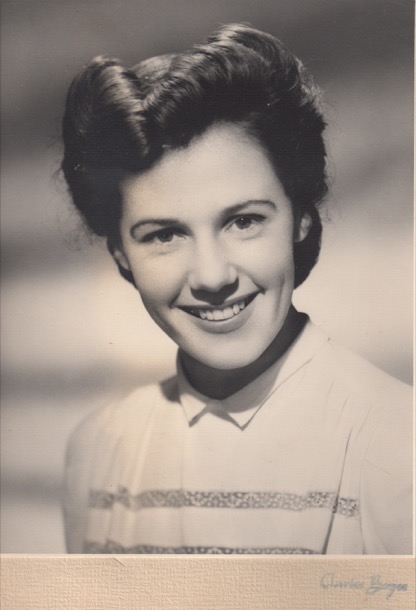
An older Marge, maybe just twenty, posed for this studio photograph as a young woman of the war years, in the “hottest” style of the time. This photograph shows a confident young woman with a job, and presumably many admirers.
During the war, particularly during the Battle of Britain, the ‘Victory Roll’ evolved as a very popular and flattering hairstyle. The style was based on an aerobatic manoeuvre performed by pilots to signify victory. The planes would spin horizontally in celebration. The ‘Victory Roll’ hairstyle would have been difficult to execute, so hours of practice and experimentation was required. The style has stood the test of time, as it is still popular today in ‘retro’ dressing. There are many YouTube videos available with full and detailed instructions.
‘THE SET ‘
After the second world war, women’s hair fashion was dominated by ‘the set’, often a weekly set. Some women did their own at home, but others, such as our mother Alice, went to their local hairdresser.
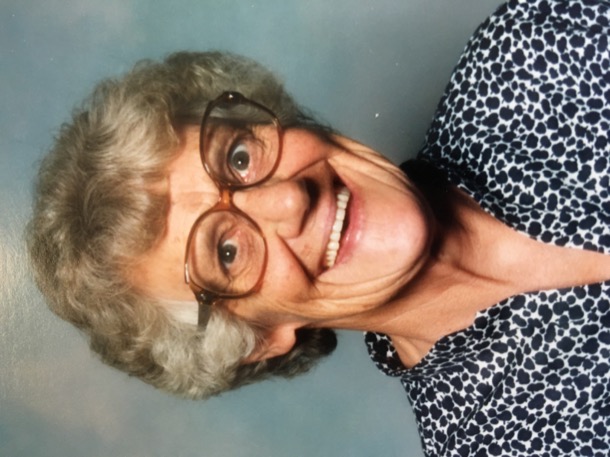
The set involved a headful of rollers, tightly wound on wet hair, then dried under a hood dryer. This often took almost an hour, so there was time to read or chat.
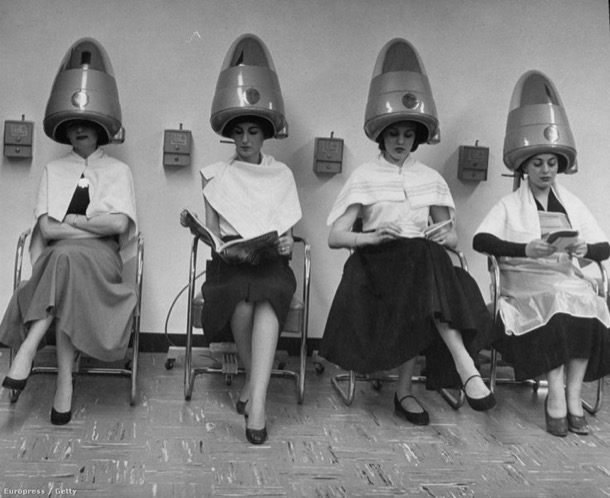
Through the ages, and the generations of our family, both sexes’ hair styles have been influenced by the fashion of the day. We have all had cuts, or not. We have curled and permed and coloured and bleached, with varied results.
Today, people are not rigidly restricted to one style, as they were in the past, but have any options.
The lyrics from the musical Hair says it all: .
‘Gimme a head with hair
Long beautiful hair
Shining, gleaming,
Streaming, flaxen, waxen’
Women's Work
Like women throughout history, most of the women in our family have had the primary job of parent and homemaker. Those homes range from simple pioneer cottages to majestic residences with grand staircases and sweeping verandahs. Nearly all of those women have also done paid work. And some of those who have not been specifically employed, have had supporting roles in their husband’s careers. Some jobs have been done by different family members across different generations.
None of our women have had traditional men’s careers, but, across the generations, we have covered a wide range:
AGRICULTURE (Dairy maid, Famers’ wives)
HEALTHWORK (Doctors’ wives, Aide, Occupational Therapy Assistant)
HOSPITALITY/TOURISM (Publican, Office Administraion, Horse Trail Guide)
RELIGIOUS SERVICE (Lay Preaching and other good works, Nun)
ADMINISTRATION (Postmistress, Sales Administration Supervisor, Office Administrator)
THE ARTS/CRAFT/DRAFTING (Whitework, Semco and Dressmaking, Drafting and Drawing Office, Drafting, Drawing and Card production, Art and Craft Activities for At Risk Children, Set Design and Construction, An Artist in the Hills)
RETAIL (Grocer, Checkout Chick)
SCIENCE (Laboratory Work)
EDUCATION (Teacher)
AGRICULTURE
Dairy Maid
Our paternal great, great grandmother, Catherine Bourke, née Kelly, worked as a dairy maid in Limerick before marrying Michael Bourke, and emigrating to Australia, in 1839. When they arrived in Melbourne, their first job was managing a dairy farm in Moonee Ponds. Catherine’s knowledge and skills no doubt influenced this decision.
The “famers’ wives”
A recent (2022) Guardian article tells us that, until 1994, women could not list “farmer” as their occupation on the census form. Instead they were viewed as “non-productive silent partners”. Even today, when 49% of real farm income is contributed by women, our image of an Australian farmer is almost entirely male. This puts “farmers’ wife” in this exploration in a particular light.
Another interesting aspect of these women from our family history is the divide between the wealthy squatters and the ordinary people of the land.
Martha Rye, the “poor little thing”, whose story we told in the June 2016 post, was a “farmer’s wife”, as was her mother, Elizabeth. Both of these women had very large families.
Elizabeth, our great great great grandmother, had eleven children. We can work out quite a bit about Elizabeth from a newspaper story, written about her husband, Adam’s life. She had worked in service, as a housekeeper, before she and Adam emigrated to Australia, in 1848. She could read, but not write.
They grew potatoes and onions, first on a rented farm near Geelong, then on two acres in Broadmeadows. The whole family would have been involved in the farm work, especially at harvest and market times.
We know that Adam not only worked as a labourer on neighbouring farms, but also spent time away trying his luck on the goldfields. It would have fallen on Elizabeth and the children to keep things going on the farm.
Martha, Elizabeth’s daughter, was married to Joachim. They would have had long days on the dairy farm, Heather Farm, near Kilmore. We learned a bit about her from her daughter Sarah, born in 1866. We wrote about this in August 2016. Sarah wrote with sentimental nostalgia about milking the cows, Blossom, Peggy and Strawberry; feeding poddy calves; working the separator; and rearing seventeen children. But between the lines, one can see the massive workload.
Around the same time, our paternal great great grandparents, John and Johanna McCormack, bought their 15,000 acre grazing property, Balham Hill, fifty kilometres to the west. So, in a sense, Johanna was also a “farmer’s wife”. But what a different life! John, a Justice of the Peace, and community leader, had staff to attend to the farm. Their four surviving children all went to boarding school in the city, for their secondary education.
John’s father, also called John McCormack had also been a wealthy grazier. His wife, Grace, lived there at the property “Landscape”, at Tallarook, until her death aged 83. I doubt she would have thought of herself as a “farmer’s wife”.
Two generations on, Johanna’s granddaughter, our Auntie Tish, also married a farmer, near Warrnambool. Matt Rae was probably more of a hands on farmer than John McCormick, but he, too, was considered a grazier, and Tish’s life did not run to milking cows and feeding poddy calves.
Around 1950, close to the time Tish became a “farmer’s wife”, our mother’s aunt, Beat, and her husband Bill, sold their Surrey Hills grocery and bought land for a dairy farm in Cockatoo. The activities on this farm were similar to those at Heather Farm, a hundred years earlier: milking, feeding calves, working the separator. The difference in their lives is technological. An electric milking machine and separator, tractors, hay bailers, meant that they ran a dozen cows instead of three. And they had three grown children instead of seventeen. Nevertheless, they all had to work hard to make the farm pay enough to support them all. We wrote in detail, in our November 2017 post, about our childhood visits to this farm. There we described Beat’s pigs. This was her major farming contribution. She was not just a “farmer’s wife”, but actively involved in the decision making and physical work of the farm.
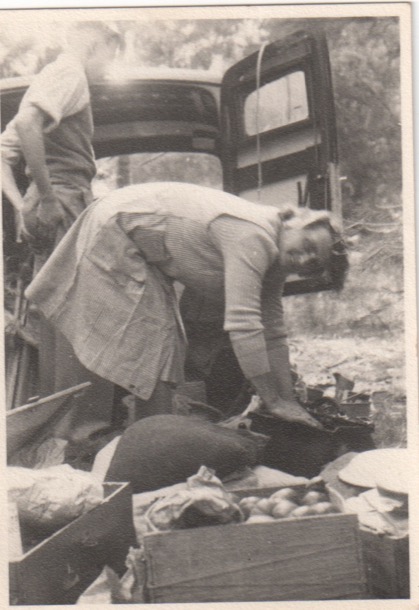
Auntie Beat
HEALTHWORK
Health work does not feature much among the women in our family. there are no doctors or nurses, that we know of.
Doctors’ wives
Our grandmother, Grace, and her daughter, Joan, were “Doctor’s Wives”. Wealthy, well connected, pillars of society, these women had no real job. In both cases, their husband’s surgery was within their house, but they were not required to deal with actual patients.
Among the women in our family, there are a few cases of unskilled health work.
Aide
Like so many women, our mother, Alice, “went back to work” when her youngest child was about ten years old, in 1966.
The only job she had had, since leaving school aged seventeen, was the wartime munitions work she had done at Maribynong, which today would have been called Lab Technician.
What skills did she have to draw on, apart from housework and parenting?
So her job as an “aide” at Lady Herring Spastic Centre was a low paid, unskilled one. She was assigned, with one other carer, to a “class” of Cerebral Palsied kids roughly the same age, none of whom had the ability to speak, and many of whom could not feed themselves. This was before the days of Communication Boards, so even the most able kids could not communicate much.
I, too, had a job at Lady Herring, after I finished school, and before I began the university year.
The centre was in Malvern, and Alice, and I, for the few weeks I was there, travelled by tram, along a very familiar route, down Riversdale Road.
There were a few qualified staff at the centre, physiotherapists, occupational therapists, but the program, such as it was, seemed to be up to people like Alice to devise. With the exception of the bus drivers, the whole staff, including the boss, was female.
The kids commuted on a special bus, and spent the whole day at the centre. Much of the time was filled with dealing with their physical needs, but there were excursions, shopping trips, walks around the neighbourhood, music sessions, and a memorable overnight “camp”. Although low status and poorly paid, it was stimulating, challenging work.
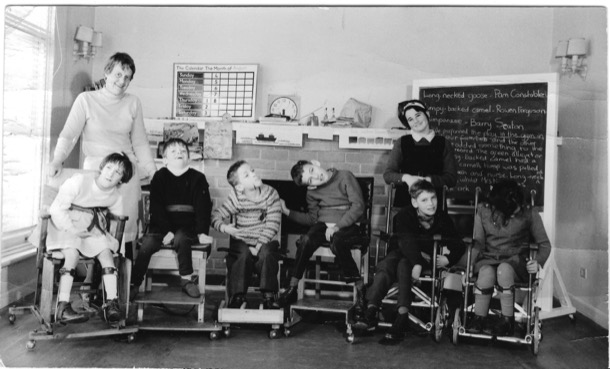
Alice with her "class"
Occupational Therapy Assistant
On the strength of my experience at Lady Herring, I did two other holiday stints as an OT assistant.
I worked with our OT friend Rikki, at Fairfield Infectious Diseases hospital for a little while. This was before HIV made it such an important place. My memories of Fairfield include the beautiful historic buildings; dozens of beds in a row, in the children’s Hepatitis ward; and the iron lung ward: people who had contracted polio as children and spent their life lying inside huge metal chambers that helped them breathe.
My job was mostly helping tidy up the activity room, and working in the ward with the Hepatitis kids: mostly bringing them things to do.
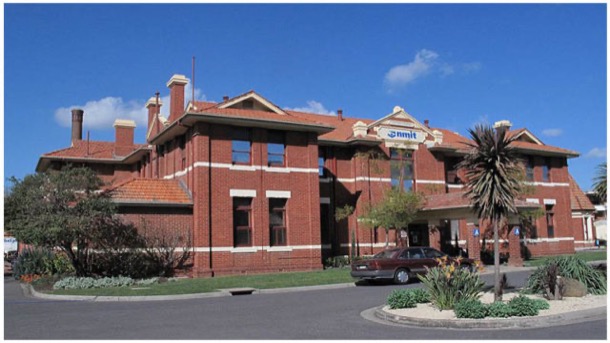
Fairfield Infectious Diseases Hospital
And then, during another long uni holiday, I worked at Montefiore (Jewish) Aged Care in St Kilda. It was perhaps 1970. Most of the Occupational Therapy “workers” there were volunteers: generally well off middle aged Jewish women doing their bit.One of those volunteers, who I remembered just as Mrs Hayman, later became Sue’s mother in law.
In my memory, the whole staff, except the doctors, were women.
In our centre, where the patients came to us, we ran activities like singalongs, bingo, games etc.
Many of our patients were post war immigrants from Europe, and some had been in Nazi concentration camps. It was the year that Melbourne emergency vehicles changed from sirens to “nee naw nee naw”, the same sound the SS vehicles had used in wartime Europe. When we heard the distant sounds approaching along St Kilda Road, we needed to be aware of some patients’ reaction.
I remember being told that that gentleman with his trousers barely held up with string, had been one of Melbourne’s top barristers. I still have the book called “Favourite Jewish Songs”, piano accompaniments I used for the singalongs I accompanied.
HOSPITALITY/TOURISM
Publican
Catherine Bourke, in her new home near Pakenham from 1844, helped with the establishment of Minton’s Creek Run, the farm in the Toomuc Valley, that they bought with another family. But in 1850, they bought the Latrobe Inn, on the main Gippsland Road, in current day Pakenham. Catherine moved out of the slab hut up the Valley, with her seven children, and became a publican. The inn became known as Bourke’s Hotel. Michael was still very involved with the family, and they had another eight children, but it was Catherine who ran the hotel.
As well as a stopping place for travellers, Bourke’s hotel was the local post office, and a hub for the community.
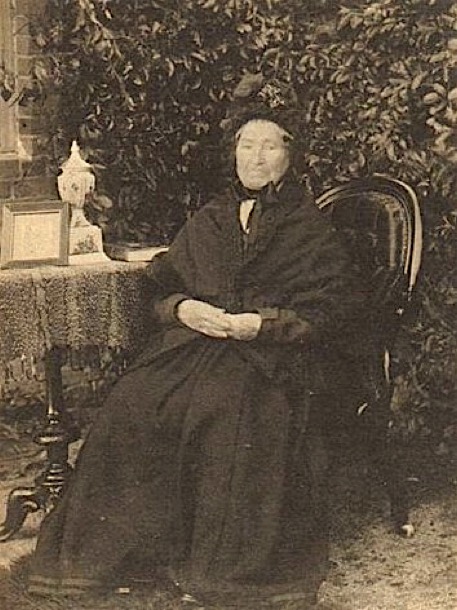
Catherine Bourke
Horse Trail Guide
Catherine’s great, great, great, great, great niece Eliza, one hundred and seventy years later, also moved to the country to start a new job in tourism. Seeking a change from office work, Eliza moved to Mansfield to work for Hidden Trails by Horseback. This company runs trails in the Victorian High Country and also at El Questro Station in the Kimberly.
In Eliza’s own words her job entailed the following:
Up at the crack of dawn. Run the horses in. Feed the ones we are working that day. Brush and saddle the horses needed for the rides.
Determine the guests riding experience, match to a horse. Sign indemnity forms, Go through basics (stop start turn etc) and then lead the ride out, float in the middle of a big group, or tail the group at the back.
We go out on four rides a day:
*AM 2 hour ride (around the station)
*Kids intro ride (around the paddock)
*1 hour loop (around a different part of the station which includes the deep moonshine creek crossing)
*PM 2 hour ride (incorporation of the 1 hour loop with a look out stop where we would take a pack horse with drinks and nibbles and tie the horses up and have a sit down)
In between those rides we feed lunch to the horses working. Then back to the stables in the afternoon, Unsaddle, wash down and tip out the horses. And then do it all again the next day. Shuffling them around in different paddocks so we could keep them all in work.
There was 40 horses total.
Long days. Great experience.
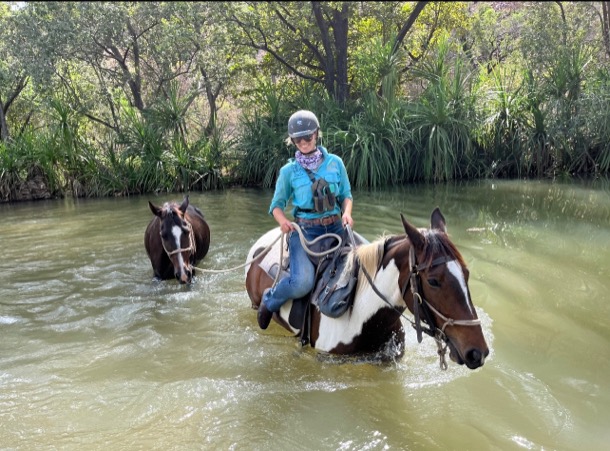
Eliza at El Questro
RELIGIOUS SERVICE
Lay Preaching and other good works
Both our mother Alice and her maternal grandmother Emma Coates (née Dau) were staunch protestants and indulged in a little lay preaching and good works.
Emma Dau, one of seventeen children, was married to Alfred Coates, who was a Wesleyan Methodist Pastor. Emma’s married life consisted of raising a family, and her duties as the Pastor’s wife. Family stories tell of her devotion to these duties and of her riding around the parish on a push bike.
At some stage in her life, when our mother was still a child, Emma also became a Home Mission Sister and was known as Sister Bessie. As a Home Mission Sister, Emma wore an impressive uniform, that is described vividly by our mother and Auntie Marge, who as children were very impressed by this formidable woman. Here they are discussing her:
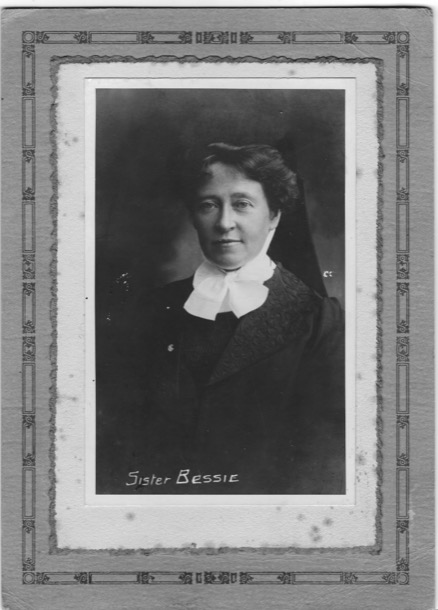
Sister Bessie
Sister Bessie worked at the Methodist Home Mission in Brunswick Street Fitzroy, in the 1920s and 30s. Sister Bessie’s work with the ‘fallen women’ and the poor, in the slums of Fitzroy was also vividly remembered by Marge and Alice. Sister Bessie’s good works involved anything from delivering babies to rescuing unmarried mothers. All of this was carried out ‘in the slums’ and in ‘poor, dirty houses’. One story has it that Sister Bessie once took off her own petticoat to give to a poor woman who did not have enough clothing.
The slums of Fitzroy were indeed slums, with a reputation for dirt, filth, disease and crime, a fearsome place. Streets were unpaved, there was no running water in many of the crowded and small weatherboard houses and children often ran barefoot.
So bad were the Fitzroy slums, that in the 1950’s they were demolished and the population was moved to the Housing Commission Towers, still standing in Brunswick Street.
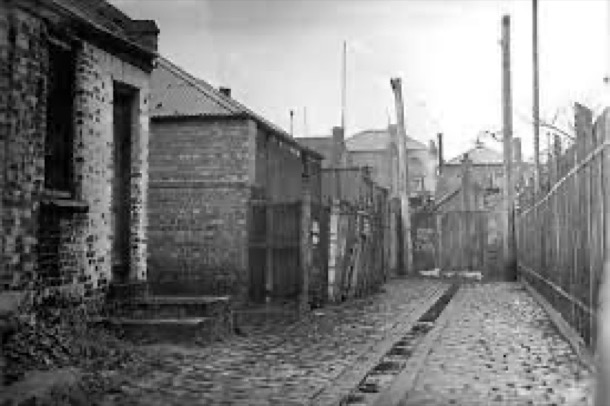
Slums in Melbourne
Sister Bessie also travelled within Victoria and Tasmania. She was lay preaching, called ‘deputation work’ and raising money for the Home Mission. Apparently she was a very good story teller and must have not only impressed her young grand daughters but also her audiences, as she regaled them with stories from ‘the slums’. So impressed was one small child, that she gave up her doll ,to be given to the poor children who had no toys.
Half a century later Alice stood in her grandmother’s shoes at the same pulpit of a small, now Uniting Church, at Jung in the Wimmera.
Alice was also doing ‘deputation work’ in a fashion, preaching about world poverty and inequality. She was also raising money for the Uniting Church’s fight against poverty. Alice mentioned that her grandmother, Sister Bessie, may also have preached here. Incredibly a member of the congregation remembered as a small child listening to Sister Bessie preaching and telling stories. She said,“She was a wonderful story teller.”
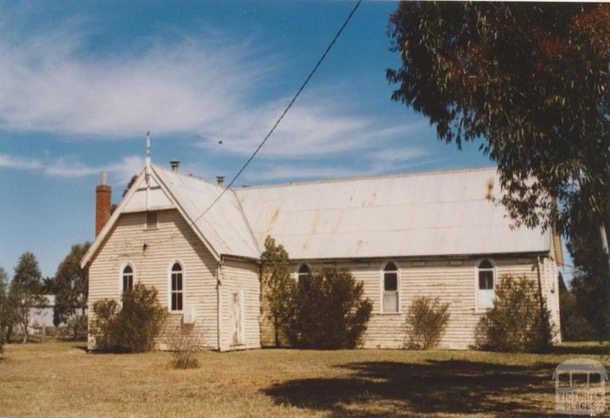
Jung Methodist Church
The Nun
We grew up with stories of a nun in the family but knew no details. With the assistance of Google, we now know that Frances Bourke, [1883-1964] Jim’s Great Aunt, joined the Presentation Sisters, probably as a young woman, and became Sister Magdalen.
Presentation Convent was founded in Windsor in 1873 ,after a request by the Parish Priest for sorely needed teaching staff at St Mary’s school.
We are intrigued about Sister Magdalen and her role. Was she a teaching Sister or did she have another role at the Windsor Convent? Did she spend her life in the Order? Watch this space, hopefully more to come.
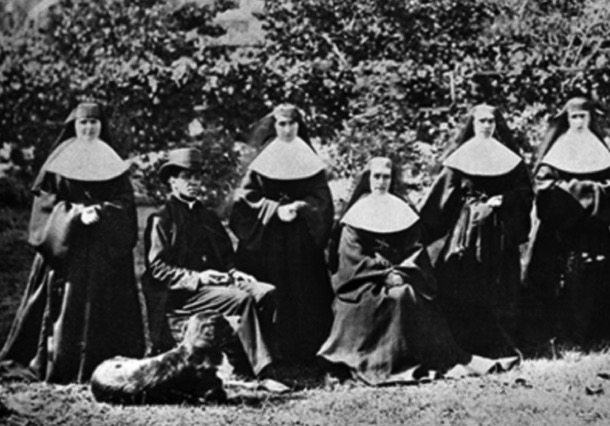
Presentation Sisters
ADMINISTRATION
Administration is part of many jobs, often the least pleasant part; writing reports, managing co workers, attending meetings, communication, ordering supplies, keeping records. These tasks are familiar to many workers.
Postmistress
In 1859 Bourke’s Hotel in Pakenham also became the community post office, ten years after Michael had bought the license. He became the founding post master of Pakenham. After his death, in 1877, Catherine became the Pakenham postmistress.
Up until 1901, each of the colonies operated their own postal service. After Federation, they all merged to become the Postmaster Generals Department (PMG).
Cecelia,(Cissy), Catherine’s youngest child, who never married, continued the role after Catherine’s death in 1910.
The job of postmistress would have involved taking sacks of mail to and from the Cobb and Co coach, later the train, and sorting it for people, who would come in to collect their mail.
Over time, the job of post mistress also included a savings’ bank, money order office and telegraph station; quite an important role in the local community.
Sales Administration Supervisor
But for a proper administration job, Tessa is our woman. Her job at Kenworth Trucks is to project manage the outfitting of each truck. She manages a team of people who put 22 trucks per day together, to the specifications of each customer. Keeping all the balls in the air, making sure everyone is gainfully employed, smoothing relationships with customers and between workers, maintaining records, supervising departments. It’s a very large and stressful job.
Office Administrator
Another organised young woman is Eliza who has also worked in office administration, at Nautilus Training and Curriculum, the company founded by her dad, Ian.
THE ARTS/CRAFT/DRAFTING
Whitework, Semco and Dressmaking
Three of our women worked in the textile industry, a generation apart. Both Great Aunts Bert and Beat and our Auntie Marge were involved in the embellishment of textiles with embroidery, and in dressmaking.
In our post on Auntie Bert, ‘A Sterling Character’, in March 2019 we explored ‘Whitework’. Whitework embroidery is the general term for hand embroidery worked with white thread on white fabric. It was used on many household items from babies’ bibs and tea towels to under clothes. Bert and Beat who, as young women, worked in this industry, probably worked in Flinders Lane. At this time it was the centre of the “rag trade”.
Auntie Bert, being unmarried, needed to continue in the workforce, but also be available to help her elderly parents with whom she lived. A talented and resourceful woman, she started a dressmaking business, working from home. Although self taught, her reputation for fine tailoring and expertly fitted ladies’ wear soon spread amongst the ladies of Camberwell and Surrey Hills. As her clientele increased and business grew, she had to move to bigger premises, and Bert leased space for a workroom and office in Riversdale Road Camberwell. This business is also described in our post ‘ A Sterling Character”
Drafting and Drawing Office
Our Auntie Marge worked in a number of drafting and drawing offices during her working life. After her short stint teaching, Marge began work in a drawing office in Collins Street, and then, during the war, moved to the drawing office at Maribyrnong Munitions Factory where Alice also worked. In 1941 Marge moved again, this time to the drawing office at ICI.
Later in life, Marge used her artistic talents at Semco, designing patterns for embroidery transfers. The designs were created as line drawings and printed onto tissue paper transfers, to be sold to women to embroider for items for the home, or as gifts. The transfers were ironed onto cloth after which the item could be embroidered accurately following the design. Margaret and I can remember embarking on an Semco embroidery project that I don’t think we finished.
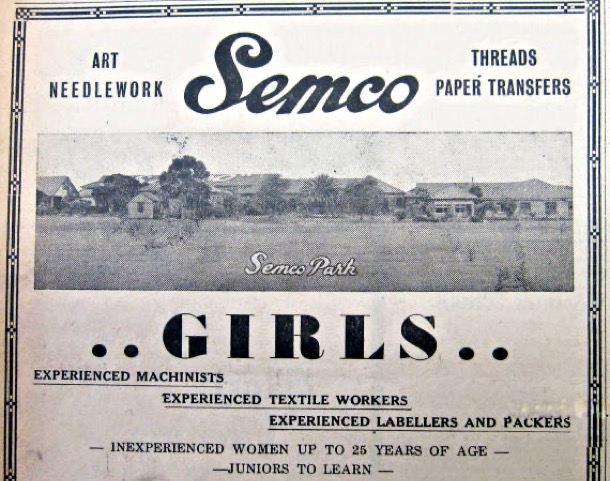
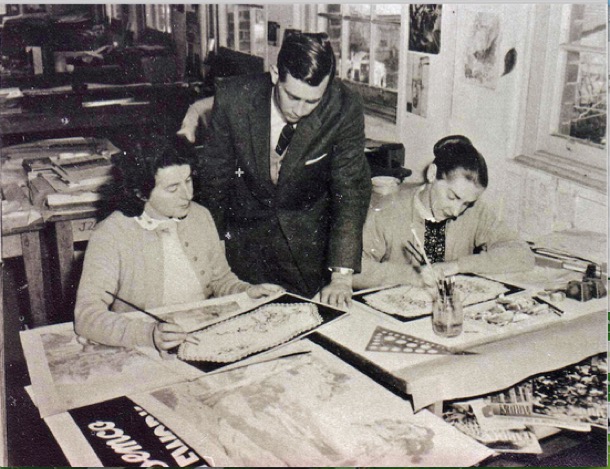
Semco Workroom
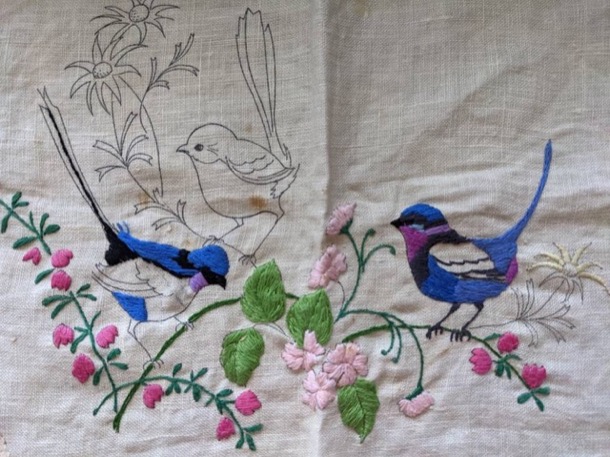
Typical Semco Embroidery
Designs subjects were flowers and animals, both European and Australian, cute houses, toys and even landscape scenes. Amongst the many items destined for embroidery were doilies, tablecloths and serviettes, tray cloths ,handkerchiefs, babies’ outfits and children’s clothing.
Margaret and I can also remember visiting Auntie Marge at Black Rock and seeing her designs on a big drawing board. A working mother was a novelty for us, as our mother did not work outside the home.
The Semco factory and workshops located in Semco Park, Black Rock, was quite a progressive company and treated its employees well. They paid award wages to women, and provided recreation facilities for the staff, including six and a half acres of garden and lawn for their enjoyment. It was a large employer, as not only were the designs created and printed, but the embroidery cottons were also spun and dyed.
Marge worked for Semco as a part time employee, and at the same time studied Interior Design at RMIT. Both were unusual. For many women of her era, part time work outside the home was difficult to find, even once children were at school. Marge was fortunate to have Semco in her area and for it to be accessible on public transport. This allowed her to work there for many years, while pursuing her life long interest in further study.
Drafting, Drawing and Card production
Marge worked in a number of drafting and drawing offices during her working life. After her short stint teaching, Marge began work in a drawing office in Collins Street and then, during the war, moved to the drawing office at Maribyrnong Munitions Factory where Alice also worked. In 1941 Marge moved again, this time to the drawing office at ICI.
In between jobs outside the home Marge, like her Aunt Bert, started a business from home. Using her artistic skills and her design experience at Semco, Marge launched a greeting card business. She designed and screen printed the cards, packaged them and sold them to shops specialising in handmade original work.
Art and Craft Activities for At Risk Children
From this heading, it is obvious that this position could be fraught with difficulties. As a nineteen year old I was blissfully unaware of the worlds these children came from. Orana was a Uniting Church children’s home for at risk children and ‘orphans’. I remember mostly a group of cardigan and jumper clad children in skirts and shorts, traipsing into a linoleum floored space to participate in whatever I decided to do. I don’t remember anyone checking the activities, or that I had to run them past any of the staff. Some of the activities were very, very messy, but the children willingly helped me clean up. The confronting and difficult part of this job was not the behaviour of the children, but the heavy prevailing air of sadness in that place.
Set Design and Construction
Lois learnt woodworking from her dad. Together with her design and craft skills, she developed her “Top Props” business, designing and creating stage props. For instance, Deirdre’s Tappers’ concerts would not have been the amazing spectacle they were, without Lois’s colourful props.
An Artist in the Hills
Through her meticulous fine drawings and paintings Katherine explores a fantasy world inhabited by little creatures and characters, who are at home with spiderwebs and toadstools or nestled under gnarled old trees . Working from her house and studio in the Dandenongs, she is pursuing her interest in children’s book illustration.
RETAIL
Grocer
Our Great Aunt, our grandmother’s sister, Beatrice Morris (nee: Holm) owned a grocer’s shop in Maling Road, Canterbury, for a number of years. Bill Morris had previously worked at Lawson’s Grocer in Middle Camberwell , so having experience, this was a logical move. We are not sure how long they were in Maling Road but presumably Auntie Beat helped in the shop as well as raising a family of three boys. It must have been reasonably profitable, as during this time they built a house in Balwyn, and then sold the business to buy the farm, Sefton Park.
“Checkout Chick”
Anna, Beatrice’s great, great niece, is the only other woman in the family who has worked in retail, and this too was in grocery shop: the Renaissance Supermarket, Hawthorn, in the 1990’s: it was a supermarket of course. At sixteen Anna was keen to have a part time job and earn her own money. Her position was ‘checkout chick’, working on the register, before scanning of prices using barcodes was all entirely automatic. For instance, the checkout chicks had to memorise the PLU code for all the individual fruit and vegetable items, and this had to be entered on the register, manually.
SCIENCE
Laboratory Work
After the horrific use of chemical warfare (gas), on the European battlefields during the 1914-18 war, many countries began to work on ways to protect their populations from gas warfare.
Australia began its own “Chemical Defence” research program in 1926 at the Munitions Supply Laboratories, in conjunction with Melbourne Uni. They developed and assembled “respirators”.
By the time the second world war began in 1939, scientists were well advanced in this work. In 1940, over half a million respirators were manufactured at Maribyrnong Munitions Factory, and more than 500 people were employed there.
Our mother, Alice worked there, in the microscope section, testing the penetration of gas that came through the filters. When she would describe this work, she would indicate tapping and counting as she stared down the microscope. She had studied Year 11 Chemistry the year before she started.
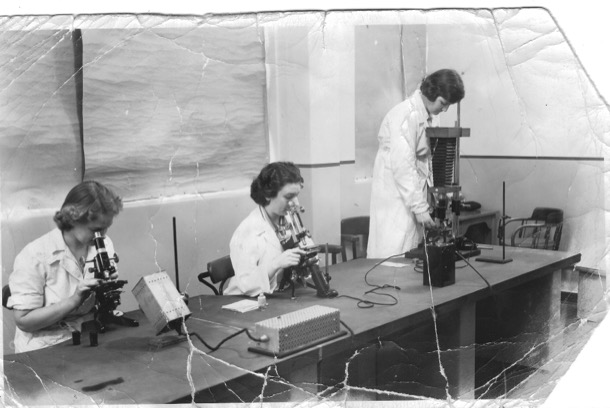
Alice, left, working at Maribrynong
EDUCATION
Teachers
At least five of the women, in four generations of our family, have been teachers, some primary, some secondary.
The earliest we know of is our Nana, Alfreda, who taught primary school, before marrying Alfred in 1916.
She had fought for a chance to continue her education after secondary school. There was not enough money for university, and so she went to Melbourne Continuation School, which later became Melbourne High School. Its focus was teacher training and thus, after two years, Alfreda became a teacher. Presumably she taught for about four years. Women had to resign from teaching when they married.
Our Auntie Marge, Alfreda’s eldest daughter worked as a teacher for a year, straight from school. She taught 50 five year olds at Balwyn North, as a “junior teacher’. She also went to RMIT three nights a week dong Fine Art, her real passion. She only lasted one year, having decided that she was not suited to teaching. Our mother, Alice, while not actually teaching, worked as a school librarian assistant for the last years leading up to her retirement.
The next generation is ours, and at least four of us worked as secondary teachers: Pauline for a few years, and Sue, Anne and I until our retirements. All three of us did our initial tertiary education, including teacher training, on “Studentships”, which provided free education and a small wage, in return for three years service, usually in the country. Sue went to Sale, Pauline to Portland, and Margaret to Moe. Sue and and I wrote about our first year teaching experiences in a post on October 28, 2015, filed under “Young Adults 1970s”
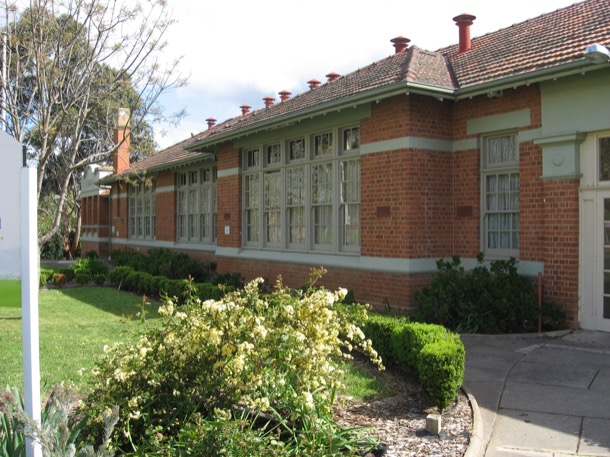
Sale High School
Of our own daughters and nieces, only Anna has taken on the mantle of teaching. She even completed most of a PHD in Education. Recently, in her mid forties, she has gone back to the English classroom in a secondary school, where she is thriving!
Such a lot of different job experiences, and yet, within relatively narrow parameters. No astronauts, truck drivers or plumbers.
And, it must be stressed, the most important job for almost all these women, over six generations and nearly a century, is that of parent and homemaker.
Auntie Bert, a "sterling character"
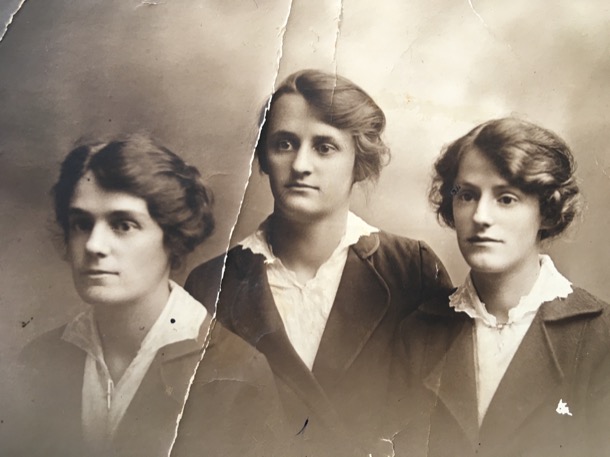
These three young women are our grandmother Alfreda on the left, with her two younger sisters, Beatrice in the middle and Berta on the right.
Alfreda’s set jaw and determined look reflect her independence and demand for an education. I fancy I can see both the rebel and the farmer in Beatrice’s broad face. But look at the gentle, faraway, passive prettiness of Berta. What experiences are already clouding her young face?
About ten percent of the whole of Australia’a population, the country’s young, fit men, set off to war in 1914. More than half of them were killed, gassed, wounded or taken prisoner. There was no such diagnosis as “post traumatic stress”, but we can extrapolate from the modern experience of returning soldiers.
What happened to the equivalent ten percent of young women, who, in different circumstances, would have been marrying them and having their babies?
Our Auntie Bert became one of the many “maiden aunts” of that very specific generation. The family lore is that she “had opportunities” to marry but “chose to stay in the bosom of her family”. We do not know what the reality of her young life was. Had she been a boy, she would have been one of the 417,000 men who enlisted. One would presume that virtually all the young men she might have had a romantic interest in… brothers of her friends, boys from church, at work, on the train, in her neighbourhood… nearly all would have been absent for four years from when she was 18 until she was 22.
Berta Holm was born in 1896. Her childhood and early adult life was spent in St Kilda.
The family story is that Berta and Beatrice unlike their older sister, Alfreda, did not hunger for an education.
Alice and Marge said this in quite a disapproving tone, which made us wonder about the accuracy of the statement, that Auntie Bert left school at Grade 4, declaring that she would prefer to help her mother at home. In Grade 4 she would have been nine or ten!
At the time Victoria was a progressive state and proud to be the first Australian state to create a system of free, secular and compulsory education. This legislation introduced in 1872, required all children aged 6-15 years to attend school unless they had a reasonable excuse. Schools were built, and a system of inspectors employed to enforce compulsory education. Fines for non-attendance were five shillings and increased for further offences. Did Auntie Bert leave school at the tender age of nine or ten? We think it more likely that she attended a State school, maybe unwillingly and, after trying a private school for young ladies, left at the age fifteen. Their disapproval of the lack of enthusiasm for education, compared to their own mother’s, probably colours the story about their aunt. The view of Auntie Bert we were brought up with, was that she was good with her hands, but, to soften and elevate this statement in true Holm fashion, it was followed by, she was a superb craftswoman and much in demand: not academic but exceptional.
Some time after she left school Berta went to work in Flinders Lane.
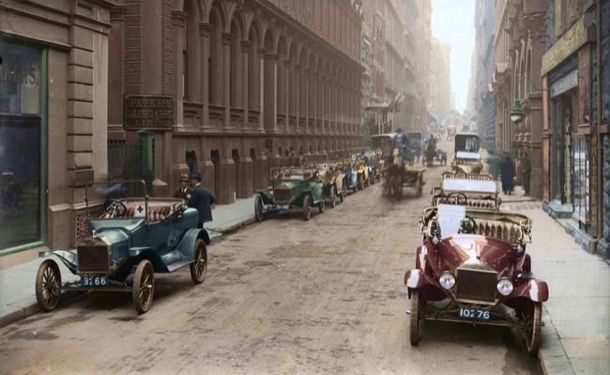
At that time Flinders Lane was the centre of the ‘rag trade’ where many Jewish firms had their businesses. Amongst them was Slutskins, for whom both Berta and Beatrice worked doing ‘white work’. Whitework embroidery is the general term for hand embroidery worked with white threads on white fabrics. It is one of the most elegant and timeless styles of embroidery and was used on underwear, night gowns, table linen, handkerchiefs, baby bonnets, christening gowns and many other small items.
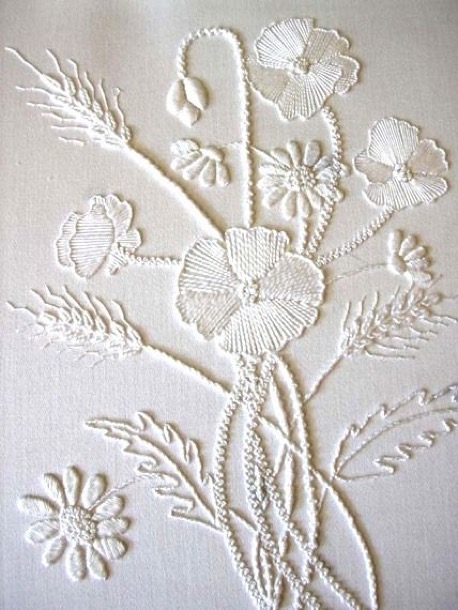
After some experience in this area Berta became forewoman, in charge of a group of other women.
We only have Alice and Marge’s childhood recollections from which to piece together Berta’s life.
In early 1925, when she was twenty-nine, perhaps moving away from her parents’ home for the first time, she left her job, probably that responsible position as forewoman. She went, for an unspecified time, to the country, to help her married sister with a toddler and a baby, and to help serve in her brother in law’s hardware shop.
Alfreda had given birth to Alice, our mother, in 1923. She had had a terrible time, alone, during her first delivery, resulting in the death of the baby. We don't know anything about Marge’s birth or the subsequent few years, except that they were quite near to family help. But when Alice was fifteen months old, Alf and Alfreda moved to Bacchus Marsh. Alfreda was “weak from the birth”. The descriptions of her crying, while scrubbing the floor and having to spend whole days in bed, apparently requiring the help of her unmarried sister, makes us think of post natal depression.
Alf too had what we would today call “mental health issues”. He was a gentle, quite scholarly person, and the business venture in Bacchus Marsh, on the eve of the Great Depression, took a toll on his health. It is no wonder Marge and Alice remember Auntie Bert as a tower of strength and support.
In 1928, the old dry house they had been living in caught fire. At the top of the burning staircase were the little girls in their nighties, Alf sedated, because he was in the midst of a “nervous breakdown”, Alfreda, reportedly trying to find her stockings, and Bert, who carried Alice down the stairs. Marge was carried down by her father, finally awake.
The destitute family were taken in by “the Pierces”. Nell Pierce was a lifelong friend of Auntie Bert. Did they meet there at Bacchus Marsh? We don't know.
The family stayed on for at least a year in Bacchus Marsh, but Berta moved back to Melbourne, once again moving in with her parents, probably her only option.
Now in her early thirties and unmarried Berta must have turned her attention to a job. As far as we know this is when she decided to start her own business as a dressmaker. At first she worked from her bedroom, building her business and reputation.
The business was eventually profitable enough to allow her to move to premises in Riversdale Road, Middle Camberwell and then to Burke Road in Camberwell, just over the junction.
I can remember the junction premises quite vividly. It was one big room on the first floor. Big windows looked out onto Burke Road, letting in light and sunshine that fell on the big work tables. Several dressmakers dummies stood in the corner where the fitting room was screened by curtains. It seemed a very busy place.
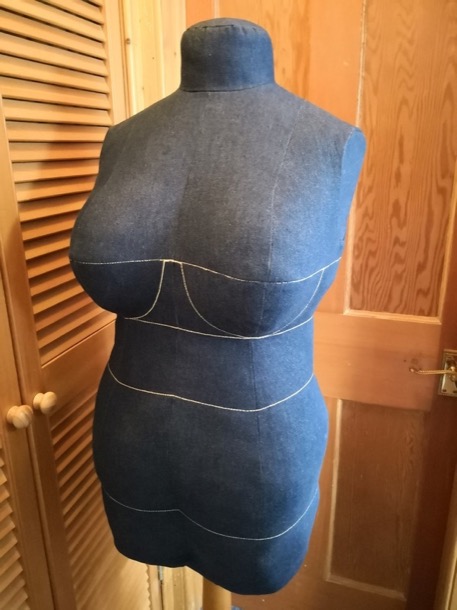
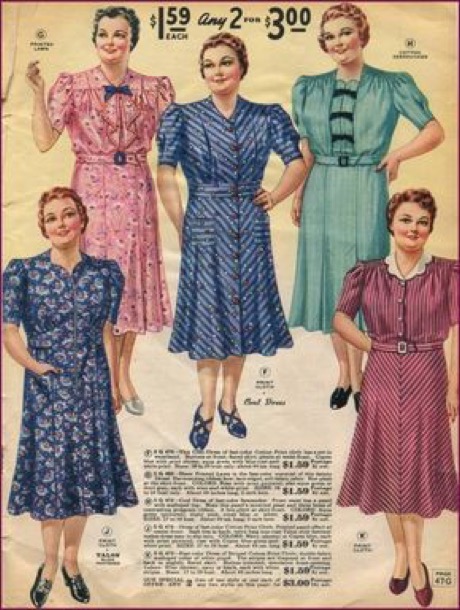
The big tables, that dominated the space were covered in the paraphernalia of dressmaking. There were several sewing machines, many reels of sewing cotton, several pairs of big dressmakers shears, other dressmaking scissors and many tins of pins. Rolls of fabric and garments in various stages of construction took up the rest of the table space. Another woman was sewing at the table, presumably an employee, so business must have been good. We were probably there for a fitting, as Auntie Bert made ‘good clothes’, for Mum. These beautifully tailored clothes were worn to Church and were for special occasions, including weddings:
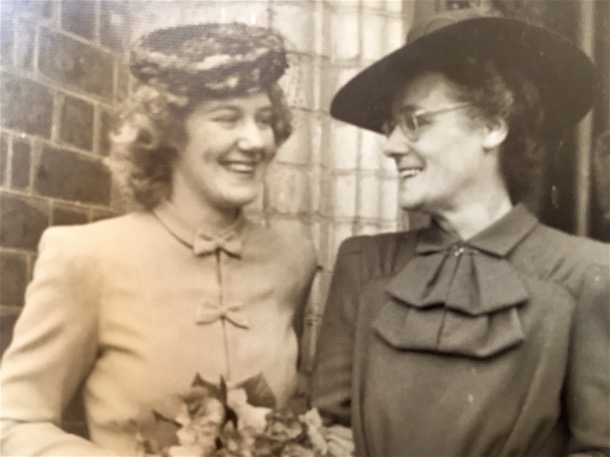
She also made us beautiful clothes including these woollen dresses:
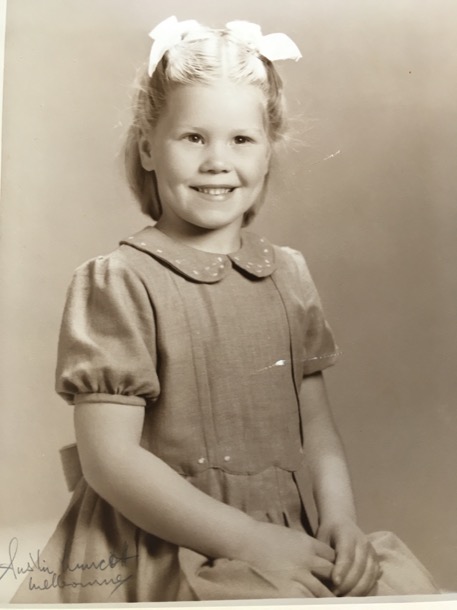
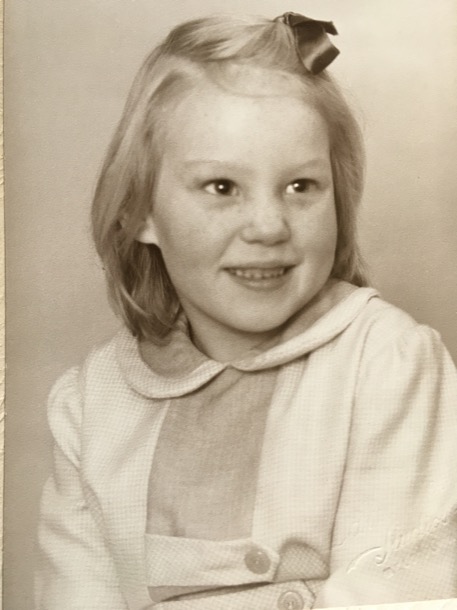
Auntie Bert had an account at Ball & Welch, a prominent department store in Finders Street, Melbourne. She needed an account for her business and a reliable source of good quality fabric for her clients. Its four floors occupied one third of the total block and stretched between Flinders Street and Flinders Lane.
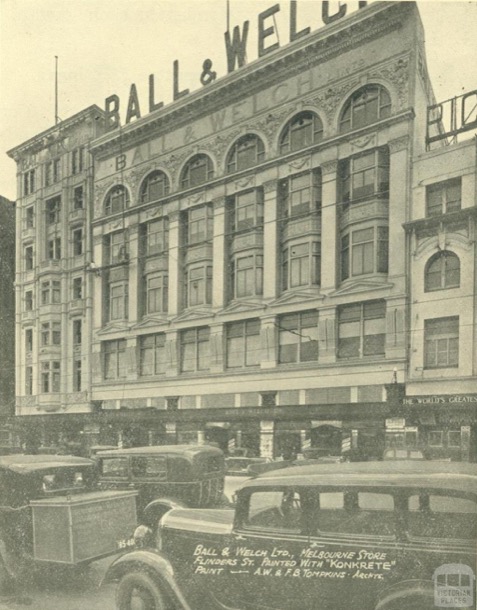
Its many departments included gloves, umbrellas and handkerchiefs, fabrics, furniture, china, millinery, furs and corsets. At one time twenty-six assistants were devoted to the sale of lace alone.
Members of the family were generously given access to Auntie Bert’s account, making it possible to buy items on account and pay later. This was very useful at times, as there was no such thing as Credit Cards. At the end of the month, Auntie Bert sent out letters to all those who had used the account, and we reimbursed her by cheque. This was probably quite a task, not only the arithmetic, but also the sending out of all the individual letters.
I can remember enjoying trips to Ball&Welch. The lifts were staffed by attendants in uniform who recited the list of items available at each level as the lift rose between floors. Parcels were wrapped up in brown paper and string, on huge wooden counters. The expert shop assistants were reserved, formal and a little forbidding to a young child. The exchange of payment was quite a process. The shop assistants' job was to serve the customers, not handle the money. When payment was made, it was placed, with the hand written docket, in a metal canister that went shooting on wires across the departments and then upstairs to the Accounts Department. The docket was checked, change inserted, a receipt written and the canister whizzed back from whence it had come. Transaction complete.
The cash-ball system worked reasonably well, but the rails were intrusive and the interior layout of some stores did not allow certain counters or departments to be connected by inclined tracks. The ingenious Lamson then hit upon the concept of the “aerial railway” and set about tinkering with a gondola-like design, which became known as the wire-line or cable-carrier.
By the late 1880s, sales staff could secure cash inside a small wooden jar or canister, suspended by wheels from a taut wire that ran overhead from the sales desk to the cashier’s station, which was typically a cage-like booth situated in the center of the store. By tugging firmly on a spring-loaded cord or lever known as the “propulsion,” the canister would be catapulted along the wire, reaching its destination in mere seconds.
The cashier could then “return fire” with change and a receipt. Cashiers who worked in booths on levels above the sales floor could simply release the canister and let gravity return it to the appropriate counter.
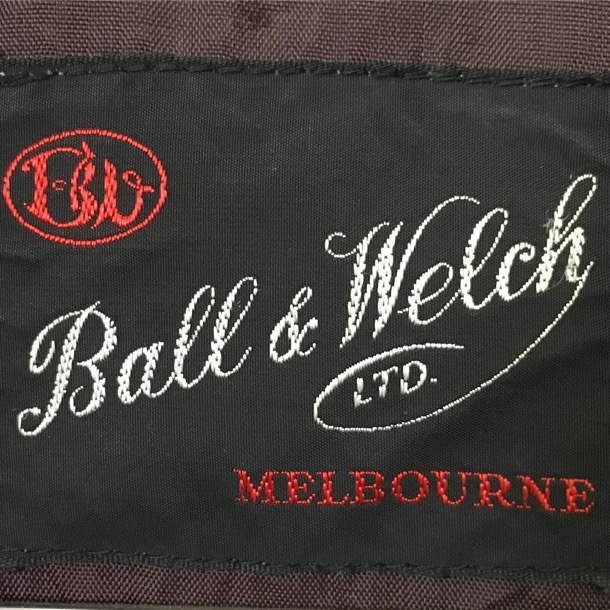
Ball and Welch closed its doors in 1970, the end of an era .
Berta’s sister, Beatrice had taken up dairy farming in the early 1950s, near Cockatoo, in the Dandenong Ranges. The bulk of the work was done by her husband, and three sons. In 1955, the wife of Rob, the middle son, died, leaving a baby daughter, Julie, to be raised by her grandmother.
Into the breach stepped Berta. She moved into a small bedroom in the farm house, and became a second mother to Julie. We remember her room. It had been part of the farmhouse verandah, and the whole room was about twice the size of the single bed. It was neat, sparse and dark.
Our memory of Auntie Bert at the farm is solely inside the farm house. Unlike Auntie Beat, who mucked out the pigs, wearing layers of old jumpers and a woollen beanie, Auntie Bert was always nicely dressed. We remember her in well-cut woollen skirts, stockings and heeled court shoes, with classy jumpers and cardigans. We picture the two of them in the kitchen, both wearing aprons, turning out scones and cakes on the wood stove. Auntie Bert became a permanent and valuable member of the family, looking after the “boys” and Julie.
While her main home and focus was life at the farm, Auntie Bert continued, as she had her whole life, to be the family helper and nurse. She had looked after both her own parents in their final years, and she came to live with us to help out with her elder sister: our Nana, Alfreda, who had dementia. We remember her as a quiet unobtrusive presence in our home. A few years later she came again and helped with Alf, our grandfather, in his final weeks.
So Alice saw first hand, the skill and care of Berta’s nursing:
Apart from staying temporarily with other members of the family, usually to help out during family crises, Berta lived there at the farm, until her death in 1976, aged 80.
Alice reflected on Berta’s death and the simple generous life she lived:
From left to right, Nana, Auntie Bert and Alice: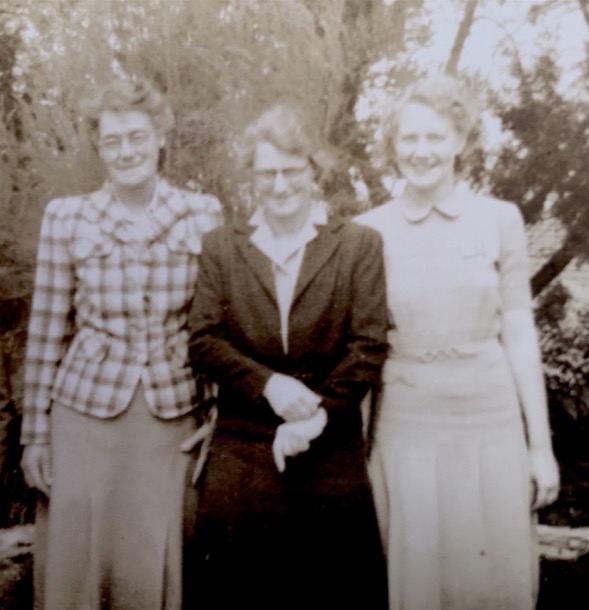
The Croydon Years
When the Coates family moved to Croydon it was the beginning of the Great Depression and many men were out of work. To complicate matters, Alf had been in partnership in a hardware business in Bacchus Marsh that had burnt down. Not only was the fire a personally traumatic experience for the family, as their house had also burnt down, but the business was not insured. As manager, Alf was responsible for the lack of insurance. He was therefore "lucky indeed" to have the job as the hardware store manager at the Croydon Timber Yard. He was on a reduced salary as recompense for the losses of the other Bacchus Marsh partners, who now owned the Croydon business.
Croydon was at that time a pretty, country town, connected to the world by the railway that ran, as it does now, from Flinders Street to Lilydale.
White settlement had reached Croydon in the 1850’s, as timber cutters arrived seeking new sources of timber for the needs of rapidly expanding Melbourne. Many small, and a few large land holdings were taken up, and fruit trees were found to flourish in the area.
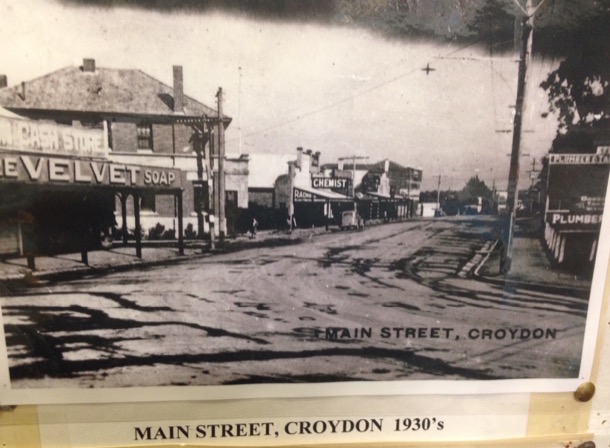
The town that the Coates family found, spread out from the railway station. Businesses and shops were strung out along the long, wide, slightly curving main street. The Dandenong Ranges made a lovely backdrop to the town that was surrounded by small farms, orchards and bushland. Home for the Coates was a small house, painted battleship grey, in Hewish Road, very near the corner of Main Street. This was the wrong side of the tracks. The expensive houses were built over the railway line in Wicklow Avenue, extending up the hill towards what is now Maroondah Highway.
They remember their house as having a beautiful backyard, graced by an enormous Mulberry tree and a large vegetable garden. There was a cow paddock on one side of the house and the Wine Hall on the other. Hewish Road at that time was unmade, covered in hard stone embedded in the clay. The Coates were right in the business end of town: Cook’s Grain Store was directly opposite and Croydon Timber Yard, not far away, also in Hewish Road. Not only did this fiercely teetotal family live next to the Wine Hall located on Main Street corner, but on the other corner was the Croydon Hotel. These two establishments loom large in their childhood memories, as they were the source of the moaning drunken men that they sometimes heard outside. Occasionally their father had to take the men home.
Croydon Hotel:
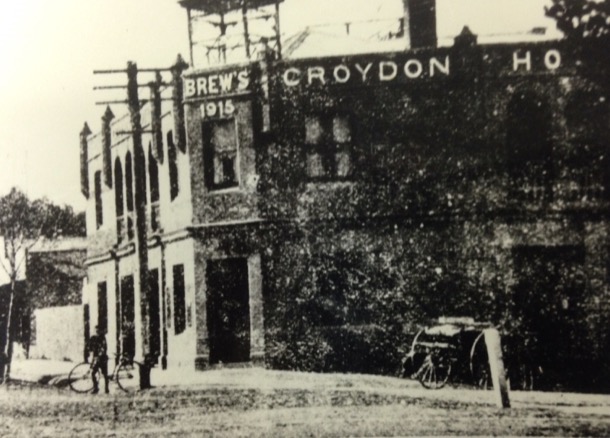
Croydon Wine Hall:
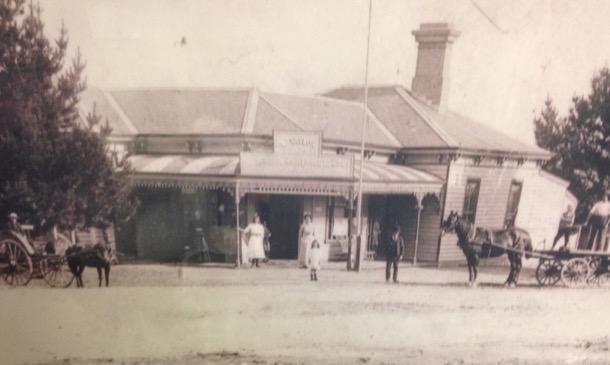
Alf worked weekdays, Friday nights and Saturday mornings at the timber yard. Once a month he also drove the truck to the wharves to collect timber.
Money was tight, especially as Alf and Alfreda wanted their girls to have a decent secondary education at MacRobertson Girls' High School in Albert Park. One-third of Alf’s wage went on rent and by the time bills were paid and weekly expenses were covered, there was not much left over. At secondary school, fees were charged, books and uniforms would need to be purchased and weekly train fares paid for. Daily life therefore included the care of livestock and the processing of milk and eggs: all quite time consuming.
As well as their home grown vegetables and fresh eggs, the Coates family produced their own milk and cream.
All was not hard work however, and the Coates’ kitchen, warmed by the one-fire stove, was the venue for cups of tea and chats, many of them about cricket. In the picture, Alf is second from the top left:
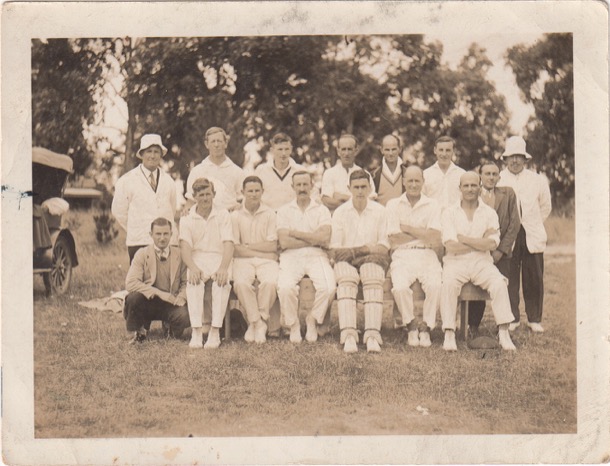
Marge and Alice had a very happy childhood in Croydon. They played often with the Cook sisters, Yvonne and Margaret, who lived opposite. The Cooks had once owned the Croydon Timber Company, Alf’s employer.
Their house was on the other side of Hewish Road, next to the hotel. Connected to the Cook’s house was the grain store, which was now the core of Mr Cook’s business. There were delivery horses in a nearby stable too, and cows in the paddocks behind. The grain store was packed with bags of chaff and grain. The girls spent many hours playing in there, climbing right up to the roof.
One happy memory is of “penny concerts”. Hours of preparation: planning, costume making, and rehearsing, culminated in a concert performed on the Cook’s wide side verandah. This seemed to be mostly in the summer holidays, when the Cook girls’ cousins came to stay. Marge and Alice sang part songs, often Elizabethan madrigals they had learnt at school: Alice singing soprano and Marge, alto. The adult audience (probably only their parents) paid a penny to attend.
Alice remembered playing a sort of scavenger hunt, following written clues to find a prize. “Next clue under the camellia bush”.
She also remembered marbles, played in the dirt on the side of the unmade Hewish Road. When Sue and I stood on the same spot in our Croydon visit, we could hardly cross Hewish Road, for traffic! In the 1930s, it was a quiet gravel road with no gutters and unmade footpaths.
The Coates and Cooks lived opposite each other, and used to signal out of windows at night across Hewish Road. They planned, but never carried out, midnight feasts.
The wild games and excitement of playing with the Cook contrasted with the much more demure and restrained Hebbard girls. Pam and Honor Hebbard were the daughters of Frank Hebbard, the Primary School Principal, and friend of Alf and Freda. Their huge library of books were available for Marge and Alice to borrow, and the garden was a delight to play in. The Hebbards lived up on the Hill, at the top of Kent Avenue, which wound up to what is now the Maroondah Highway, through foothills bushland. A favourite activity with the Hebbards was to wander this bushland looking for native orchids. The remnants of this forest are much prized today, though much of it is degraded, and many of the species of orchid are now only to be seem in a museum.
Visits to the beach, during Marge and Alice’s Croydon years, were limited to School and Sunday School picnics. But they did learn to swim. They would go by train to Lilydale, where there was a huge concrete tank, right on the side of the Olinda Creek. Fresh water would flow in and out with this quite large perennial creek. Alice remembered Mr Hebbard lining them all up along the side and getting them to enter the water with a shallow dive. Nowadays the pool has become a more modern outdoor pool, but it’s still in much the same place.
Friday night shopping was another form of fun. Marge recalled it as a chance for everyone to parade up and down the street. Alice remembered buying “sixpennorth” of lollies and sharing them out. It was a simple life for these country kids. It is notable that, three years apart in age, much of their leisure time was spent playing together.
Marge and Alice of course went to Primary School during these years at Croydon, Marge as far as Grade 8. We will spend more time on this important topic at a later date. Suffice to say, at the moment, that their parents’ friend, Frank Hebbard was the Principal, and he ran a very enlightened, rich educational program, in which the girls flourished. The Croydon Primary School has new premises these days, but the old buildings are still there, now occupied by a Community School.
Family entertainment included hikes from Croydon to Kalorama, and visits to friends, the Cheongs. They were a wealthy and prominent family in the area. At our visit to the museum in Croydon we found many mentions of them, in particular their importance to conservation of remnant foothills vegetation. Even now Cheong Wildflower Reserve, near Croydon, still fulfils that role.
Mr Cheong, from our mother's photo collection:
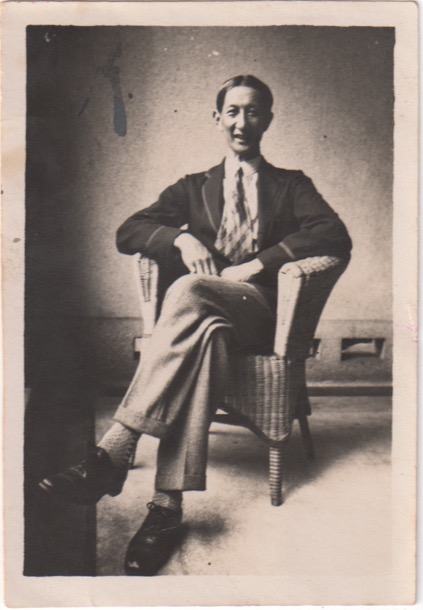
In their leisure time, many happy hours were spent in the Coates’ warm kitchen, “yarning’.
Even though much of the good food the Coates family ate was home grown, some things had to be purchased at the Main Street shops.
The Croydon years were remembered very fondly by both Marge and Alice. They were formative years for both of them. Alice actually names the four areas of interest from those years that became her life long passions.
In 1936 the Croydon years came to an end with the death of Martha Holm, Alfreda’s mother. Presumably the family had to move back to Boronia Street, Surrey Hills to help Alfreda's sister, Berta take care of Roger Holm, now quite an elderly man. Berta was working full time at her dressmaking business. Alf found a new job in the city and Alice embarked on her secondary schooling at MacRobertson Girls’ High School.
Alf and Alfreda: the Early Years
Alfreda, our maternal grandmother was living in St Kilda and attending the Melbourne Continuation School in the early 1900s. While she was finishing her secondary education. Alfreda met her future husband Alf, who was recovering from rheumatic fever and had left his country teaching position and moved to Melbourne to work at Blocky Stone, a hardware supply company. Alf boarded In St Kilda with his aunt Mishy Cowden. Arthur, Alf’s older brother had also boarded there and Arthur had an attractive young girlfriend, Alfreda Holm; not for long! Alfreda must have been quite attracted to this tall red headed young gentleman from the country. She abandoned Arthur, and Alf and Alfreda became ‘sweet hearts’ when she was 16 and he 17.
Alfreda completed the secondary schooling she had so desired. Even though she could have sat for the University entrance exam, her family could not support a full time student. Teaching was her only option. At the age of 18, she embarked on her teaching career at Elsternwick Primary School.
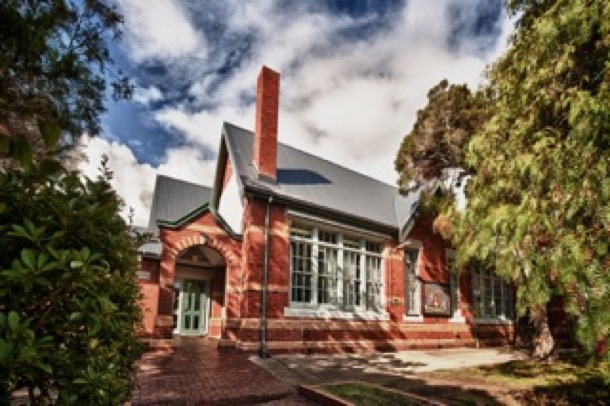
Elsternwick Primary School
Alfreda’s and Alf’s courtship was, as was the custom, a very proper affair and one would imagine that this was so, as Alf was the son of a pastor. Outings included picnics on the St Kilda Foreshore:
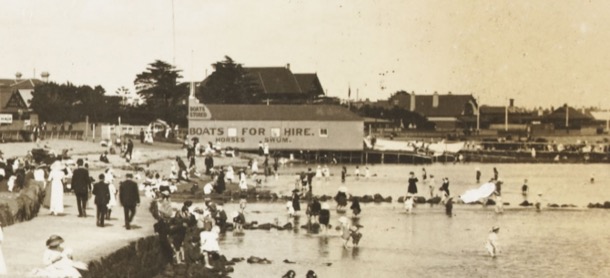
and ‘doing the block ‘ at the Block Arcade in Collins Street:
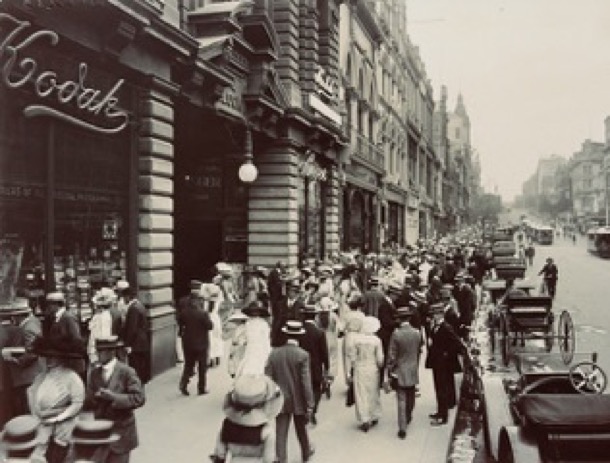
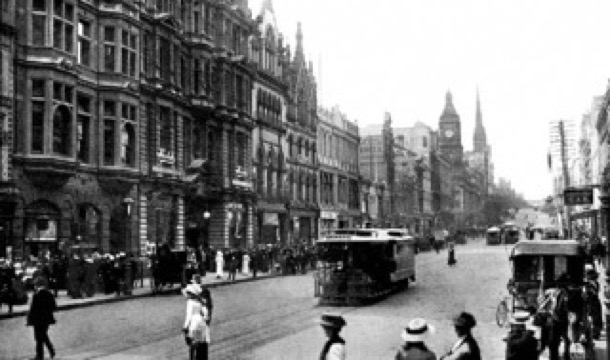
Collins Street
Alfreda pictured in 1910.
As Alf played cricket most Saturdays during the cricket season, Alfreda would have accompanied him; in fact she became so involved that she was appointed scorer.
Outings further afield involved visits to Alf’s family at Diamond Creek where Alf’s father was the Pastor at the Methodist Church. In the early 1900’s this was really the country and Alfreda enjoyed these visits and her introduction to country life.
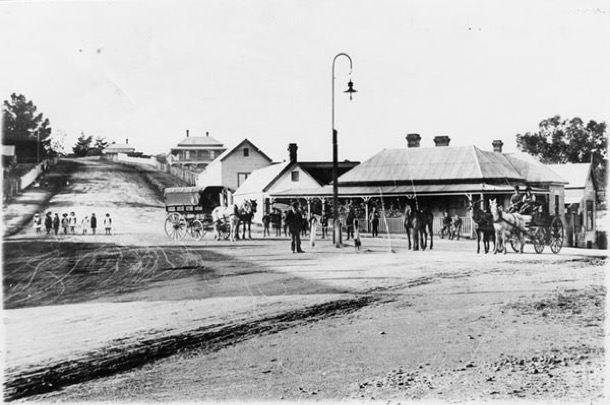
Diamond Creek around 1910
War in Europe broke out in 1914. Droves of young Australian men were enlisting in the army, hoping that it would last long enough for them to get there and have the great adventure it promised to be. A wave of fervent nationalism swept the country. Alf had recovered from the rheumatic fever that had ended his teaching career, but the residual heart damage meant that he was rejected for military service. A young man not in uniform, he was given a “white feather” as a mark of cowardice.
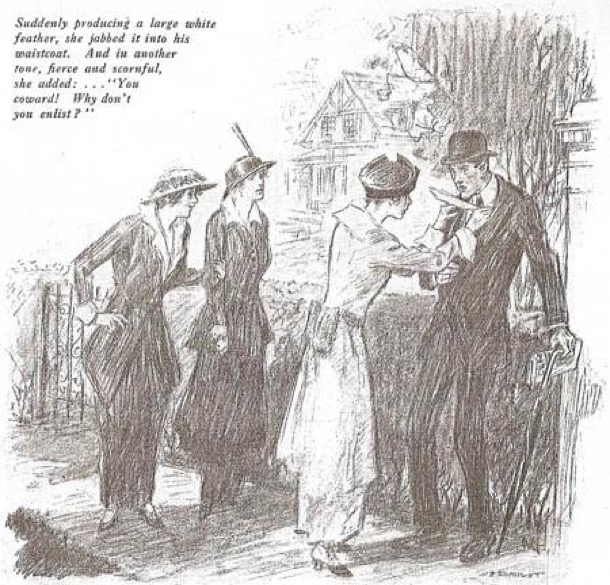
He suffered what was called a “nervous breakdown" which, at the time, was attributed to embarrassment and shame.
During his recovery, he lived in the small town of Eildon Weir, 140 kilometres away, where he managed the general store, selling supplies to the men building the weir.
Alfreda remained loyal to Alf first through his illness, which today we would call clinical depression, and then through his extended absence at Eildon Weir.
Later in 1914 Alfreda’s family moved to Surrey Hills, and Alf moved with them. Alfreda got a job teaching at Balwyn Primary School and Alf went back to his city job. They lived at Elwood Street Surrey Hills. Alf told the story of walking with a lantern down Florence Road in the early morning to catch the train at Surrey Hills station.
Alf and Alfreda were married on December 27th, 1916, at the Surrey Hills Methodist Church, which is still there today:
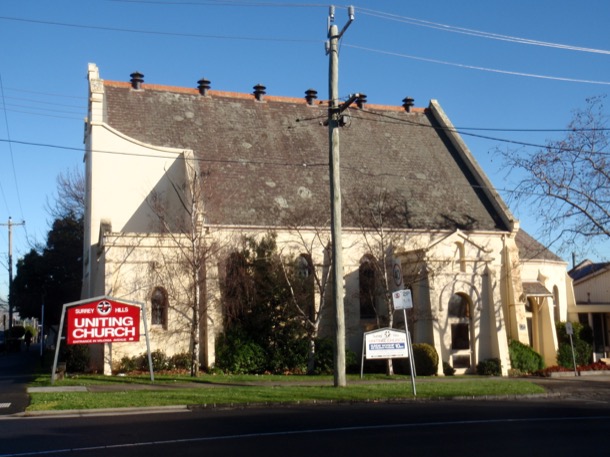
Alfreda did not dress as a bride. Marge tells us in the tapes that this was because it was war time, but a quick search shows plenty of women in full bridal regalia from that time. Perhaps they were super sensitive to how it would look, given that Alf was not “in uniform”. In any case, she wore a cream silk suit. She may well have had it made in the new fashion of flared skirts:
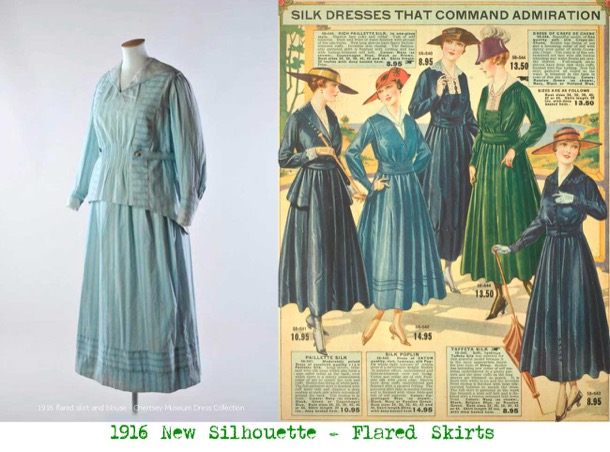
And underneath she would have worn a body moulding corset. Bras, which supported rather than moulded, were in their infancy at this time. They were patented in 1914.
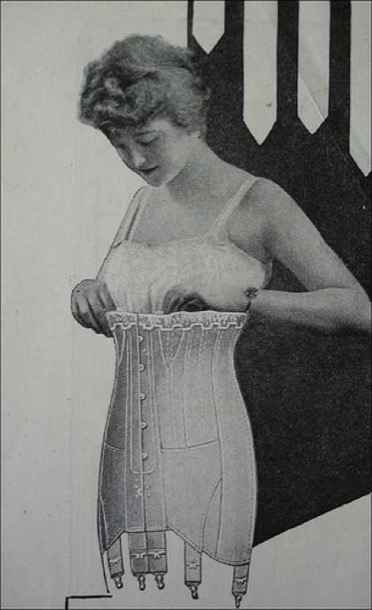
The couple honeymooned at Ocean Grove. There was a steam train all the way to Queenscliff at the most southerly part of the Bellarine Peninsular. And then there would have been a bus to Ocean Grove and finally a ferry across the river.
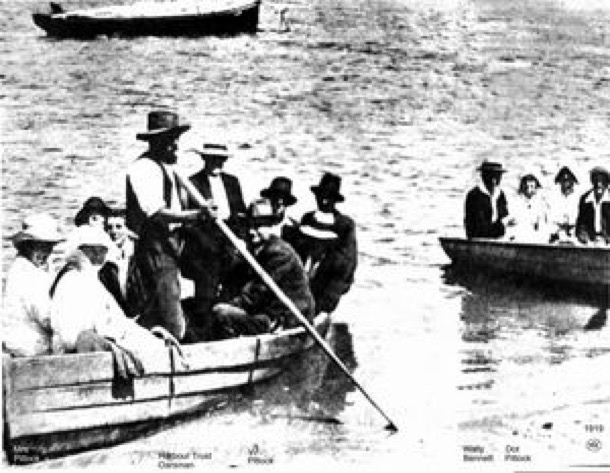
Until 1927, the only way to cross the river to Ocean Grove was by ferry and local ferryman Mr Abenathy would row you across for six pence.
Alf and Alfreda set up home back at Eildon Weir, where Alf resumed his job managing the store.

Out the front of the Eildon Weir store. Alf in a suit at the extreme left.
Alfreda had become pregnant very quickly, and the first few months of their married life had been hectic. But the still birth of the baby at seven months was attributed to a fall. It was flood time at Eildon Weir, and no doctor could get to her. A local midwife helped her through the difficulties of labour with a dead baby. She lost a lot of blood and struggled for twenty-four hours in the final stages of labour. Afterwards, she was not allowed to walk for six weeks.
Alf buried the dead child in the back yard of their little house. It was a boy, who was to have been named Peter. Interestingly it wasn’t until 1930 that “viable” still born babies had to be even reported to the authorities, and even later before they were registered. Nowadays a doctors certificate accompanies a detailed registration document, which must be lodged within forty-eight hours.
Within a couple of years the weir building project was finished, the workers dispersed and the now deserted town was swallowed up by the new Lake Eildon.

Eildon today.
Alf and Alfreda moved back to Deepdene, an eastern suburb, and Alf returned to his city job at Blocky Stone.
Alfreda Maria Holm, our maternal grandmother: the first seventeen years
We have been able, after carefully listening to the tapes, to piece together a portrait of a very interesting woman, deprived of the further education she craved because of gender and circumstance.
Alfreda’s maternal grandparents, David and Martha Bell, emigrated to Melbourne from Belfast. Her mother, also Martha, known as Matty, was their second last child. Alfreda’s father, Roger emigrated about the same time from Denmark. He was a baker and Matty ran his baker’s shop in St Kilda where they lived during Alfreda’s childhood.
Our previous, post published on 18/11/15, entitled “Great, Great Grandparents" is full of detail about Alfreda’s grandparents.
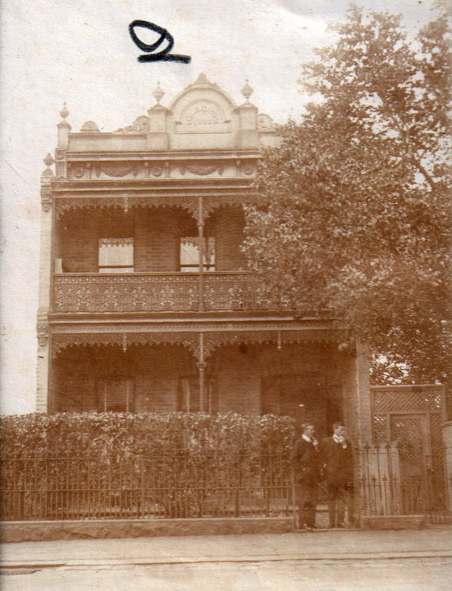
The few photos we have of Alfreda as a young woman, come from an unlabelled, unannotated photo album we found among our mother, Alice’s photo collection. I remember her showing it to us, but unfortunately, the only part of that conversation I remember is the fact that the childishly scrawled number on each photos were written by Alice, indicating the number of people in each photo. This might have been the first time I had contemplated the fact that my mother had once been a child.
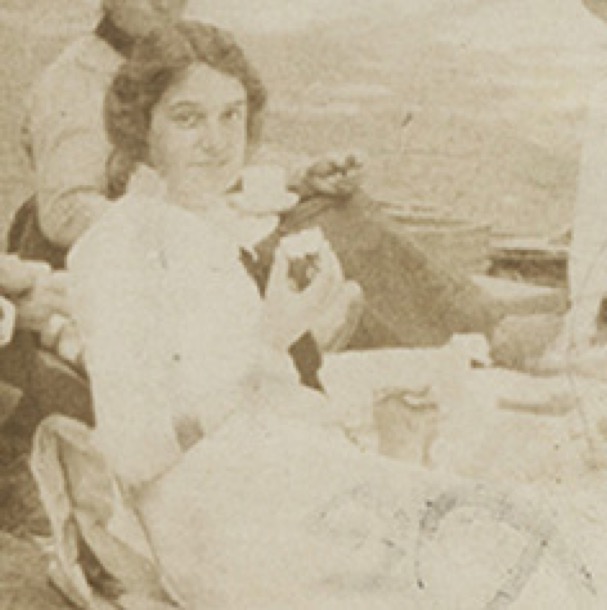
Alfreda Maria, dark and vivacious yearned for an education. This bewildered her family, as further education for its own sake, beyond that required for employment, was not known on either side of the family.
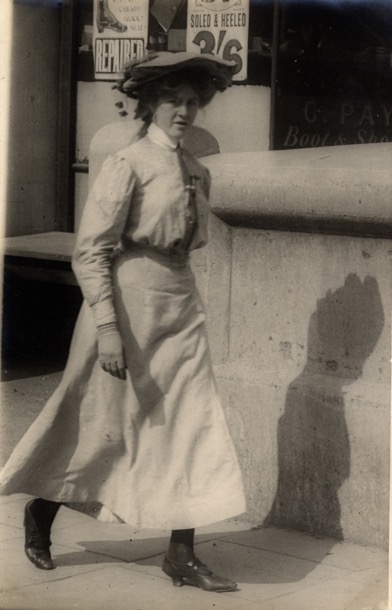
Alfreda would have worn an outfit similar to this to school
As Alfreda’s parents could not afford private school education the only secondary school available in Victoria for her to continue her education after Grade 8 was the Melbourne Continuation School. Luckily, the Continuation School was established in 1905, just in time for Alfreda.
It is to her credit that this determined, fifteen year old girl living in Edwardian Melbourne was able to pursue her dream of further education and find an opening for herself. Handicapped by her gender and lack of interest from her family, she was successful, and loved competing with the boys for top marks in Mathematics classes. She would also have had to do cookery classes: considered an essential element in a girl’s education.

At Melbourne Continuation School
The opening of the co-educational and secular Melbourne Continuation School marked the beginning of state secondary education in Victoria.
The site chosen for the school was at the top of Spring Street, now occupied by the Royal College of Surgeons.
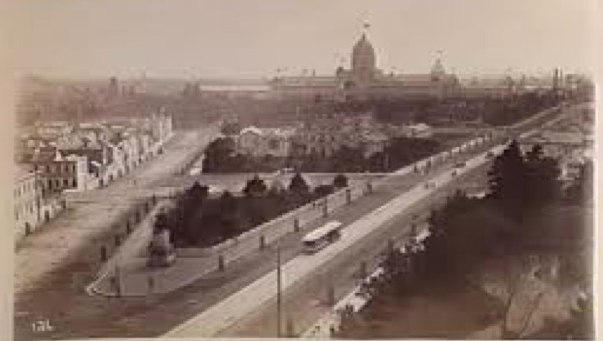
The building in the centre of this photo is the Continuation School. On the skyline is the Royal Exhibition Building.
In 1905 the Continuation School offered a two year teacher preparation course to pupils aged 14 years and above. It also provided tuition, enabling students to sit for university entrance exams. Unfortunately this was not an option for Alfreda and so, after two years further education, she began her teaching career.
In 1914, long after Alfreda had left, the old Continuation School became so overcrowded that a solution needed to be found. Consequently Melbourne Boys High was established for the boys and for the girls: MacRobertson’s Girls High School. Both of Alfreda’s daughters, Alice and Marge, were to attend this school for their secondary education.
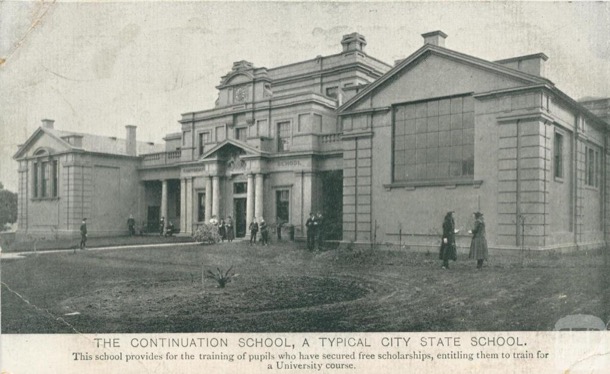
How to Rescue the World
ALF AND ALFREDA
Marge and Alice in their family history tapes, discuss Alfreda’s political and philosophical bent. The setting is Croydon in the 1930s. Croydon is a country town and it is the height of The Great Depression. Alf is working long hours at the Croydon Timber Yard and the family sell milk and cream from their cow. Many of their neighbours are unemployed, and homeless men come to their door to ask for work or food. In Germany, Hitler’s Nazi party is beginning to show its true colours and Russia has been a republic for less than twenty years. Alfreda is consumed by the great ideas of Politics and Economics. She shares this with Frank Hibbert, the Croydon Primary School headmaster.
Alfreda’s friend, Frank Hibbert was a progressive educator who shared her political views. His influence on the young Marge and Alice was profound.
There are also signs of early environmentalism in Alfreda’s letters. On January 16th 1935, she and Alf are camping at Yellingbo, by the creek in what is now the protected area for the Helmeted Honeyeater. She writes to Alice:
Yesterday was a beautiful day and in the evening just after sunset - oh! I wish i could tell you or show you how beautiful the bush was - for half an hour. What God has given us is so beautiful, but don’t humans muck things up - an ugly fence, a cigarette butt, an old piece of lolly paper thrown down. an old pair of shoes - everything we touch seems ugly after that beauty that I saw last night- even our bodies haven’t the beauty and grace of the wild things….. I’ll see we don’t disfigure God’s beautiful bush when we leave this lovely spot.
And later, in 1946, Alf gives us a taste of his own strong sense of social justice. He is visiting Marge in Sydney and has just received the news that Alice and Jim have managed to buy the block of land in Box Hill South that became our family home. He writes:
Your news about your block of land caused quite a lot of excitement in the family circle. Our own few square feet of land is of great importance in our lives. At last we are the possessors of what really amounts to an inheritance - a small portion of God’s earth which we can call our own. It was ordained that each man should have his share of good earth; but man overruled God’s laws and made his own, thereby making it easy enough for a rich man to obtain all the land he wants to, but placing every obstruction in the path of the poor man to obtain that which is morally his own. It is only when people, like you two, scrape to save the wherewithal, that you get your share, or rather, a very small portion of it. But I must keep off my pet theme.
ALICE AND JIM
This was the value system that Alice, our mother, has passed on to us. We were never in any doubt about which side of any particular issue was the correct one.
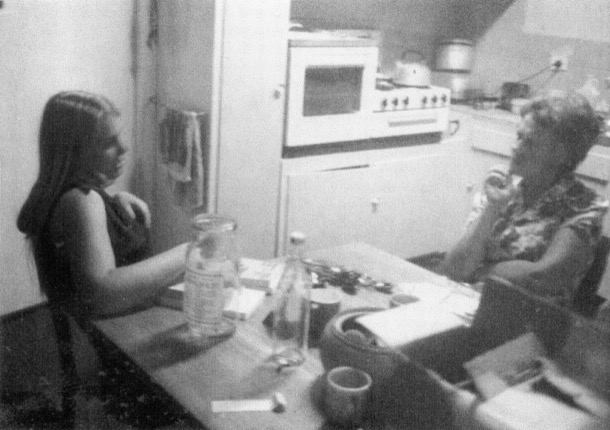
Margaret and Alice at the Moore Street kitchen table
Both Alice and Jim, our father, were staunch Labour voters, and had a strong commitment to social justice.
The world’s first atomic bomb was detonated in Japan in 1945, followed by a nuclear arms race between the USA and the USSR. Bombs were tested, and people felt that there was a constant threat of war breaking out again. Alice and Jim and a like-minded couple from our street were involved in the call for unilateral nuclear disarmament. Another neighbour, Judah Watten, a writer and a communist, was also a member of this “leftist” protest group. This was the time of anti communist McCarthyism in America, and Jim and Alice’s actions were quite radical.
Alice became more confident and able to hold her own in conversations over these years. There were many discussions around our Moore Street kitchen table about the social or political issue of the moment.
Christian social justice became her main focus during her fifties and sixties.
She was active in a number of left wing church organisations. I remember in 1975, when I was living in the country, listening to her talk on the radio about third world poverty. Even in her later years, blind and housebound, she would listen avidly to the radio and talk about politics to anyone who would listen.
Of Jim, we have fewer memories. We remember marching with him in a teachers' protest on the issue of State Aid to private schools. We are now quite used to Governments providing money to private schools, but, when first mooted by the Menzies Government, it was greeted with outrage by many. One of Jim’s concerns during the march was that he would appear on the television news and be seen by his conservative, Catholic, Liberal voting mother.
Jim was a member of the Board of Management of our family’s church, St James, Wattle Park. He was outraged when he discovered the cost of the new church building. He resigned over the issue. In his view the money would have been better spent elsewhere. This is evidence of the strength of his principles, as his role in the church was important to him.
SUE
My memories of my early twenties and engagement in ‘protest’ is of the outrage of youth. ‘How dare they!’
During my last year at College and my first years of teaching, the VSTA, the union representing secondary teachers, was very active in a campaign to improve teaching conditions. I had had an early introduction to strike action by teachers when Margaret and I marched with Dad over state aid to non government schools so I was an eager participant in the ferment.
In outrage that the State Government would contemplate increasing class sizes and teaching allotments, a couple of friends and I formed a VSTA branch and began conducting meetings. I remember calling a strike meeting and organising a boycott of classes that we were convinced would change the world. It didn't! Fancy that! We were still fighting this battle during our first years of teaching.
A much more serious concern was the Vietnam War that the US had been involved in for years and, unbeknown to the public, so had Australia! Prime Minister Menzies had mislead the Parliament and the public, and had committed Special Forces to fight in Vietnam. His successor, Harold Holt, invoking the ANZUS Treaty, upped our level of support and, as the war dragged on with no victory in sight, National Service or conscription was introduced. My family and friends were all very much against the war and the deceptive and high handed action by successive Liberal Governments. Outrage and protest was a consuming passion.
It was sometimes a bit scary! In the early days before the huge moratoriums, the numbers protesting were considerable but not large, and the police seemed to be a threatening and sinister presence. I remember the July 4th 1967 protest outside the American Consulate in St Kilda Road. I went to this one with Mum and Margaret.
It was dark as we arrived and stood with the other protesters outside the closed front gates to the Consulate. There was no visible presence in the building, as we held our anti-war banners and chanted slogans. The most sinister aspect was watching the police buses pull up across the park and disgorge many, many policemen. I remember thinking, ‘Can this be Australia?’ A noisy and highly visible minority of the protesters were quite confrontational and aggressive and were consequently arrested. We stayed well clear of the action but it was hard to avoid the police horses. They are enormous up front and personal, and were used very effectively to nudge the crowd away from the gates. Overall it was a very sobering experience and one that has stayed with me. We live in a democracy with the right to protest peacefully. What must it be like protesting under less benign circumstances?
After these small beginnings the protest numbers swelled, culminating in the euphoria of the Moratorium Marches that brought cities across the world to a standstill, including Melbourne.
The ABC captures the spirit and the times better than I can. Have a look:
http://www.abc.net.au/archives/80days/stories/2012/01/19/3411534.htm
Even though I may have wished for many thousands to take to the streets again, as they did in the Moratoriums, it has not happened on such a scale, but here’s hoping!!
The demonstrations against the Vietnam War left a profound legacy. After such a powerful and successful protest movement, it seems the natural response to feelings of outrage: paint a banner and march! As Margaret says, ‘It is part of democracy’. Aren't we lucky!
Therefore, along with thousands of other concerned people, I have attempted to ban nuclear weapons, stop the war in Iraq, stop logging of old growth forests in Tasmania and East Gippsland and persuade our government to take action to reduce emissions.
The world has changed, but not always for the better. Today, as well as the kitchen table, the letter, the banner and the march, we have at our disposal the power of global and instant communication and social media. It is the era of Get Up and ’Clicktivism’.
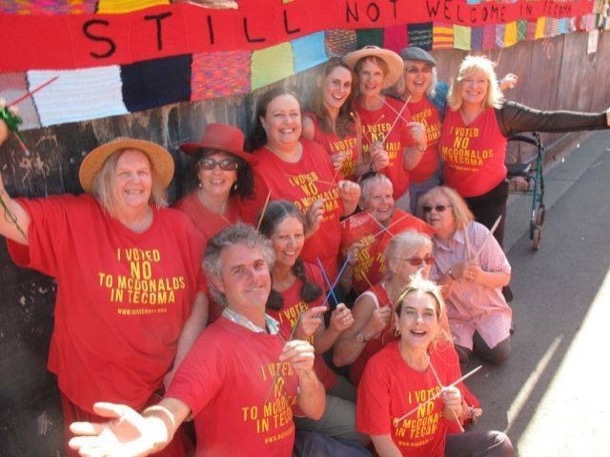
Sue and Margaret protesting together at Tecoma
MARGARET
July 4th 1967. It is winter in Melbourne and it is raining. The puddles flash …blue…black…blue…black…
“Link arms!” call the young bearded marshalls running up and down the line of marchers. We are marching on the American Embassy, protesting atrocities in Vietnam, pressurising our government to change their “All the way with LBJ” policy. Police horses charge the crowd. One of my companions, my forty-three year old mother, loses her handbag.
Five years later a New Yorker I go out with a few times, assures me that there would have been fully armed Marines in the embassy, and that they wouldn’t have hesitated to shoot, had we successfully “stormed” the building.
This was my first real “demo”. I don’t remember why it was just my sister, my mother and I there. I was fifteen.
Over the ensuing fifty years, I have waved banners demanding many things: the end to the logging of old growth forests and the creation of National parks; that uranium be left in the ground; that there be land rights for our indigenous populations; smaller class sizes; a fairer allocation of education funds and more of them; that we not go to war and/or bring our troops home; that the public service not be decimated by cuts; that the separation of power between the judiciary, the legislature and the executive be maintained; that MacDonald’s stay out of our Hills community.
Most recently I marched with Michael and Chris to urge our planet to act on Climate Change:
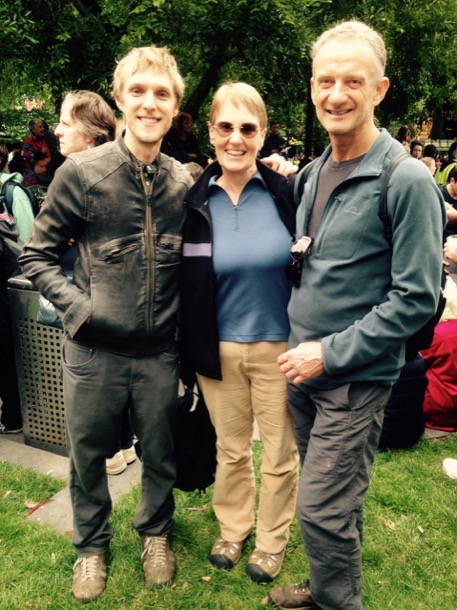
Marching for climate justice... a family affair
The thread that links these causes, is the same thread that runs back to the 1930s around the Coates’ dinner table in Croydon. It involves words like environment, justice, democracy, fairness, equity, peace, kindness and conservation.
Great Great Grandparents
Like many Australian families, ours is a story of migration to a new country. All four of our maternal great great grandparents were European: English, German, Danish and Irish.
These four migration stories happened between the 1850s and 1870s. Three of the migrants were our great great grandparents, and one was a great grandparent.
COATES, ARRIVED VICTORIA 1860s
Coates was an English engineer who travelled with his wife to Australia in the 1860s. Their first names are not known.
The Barwon River is the large river than flows through Geelong. In the new colony, there were no iron works: the worked iron had to be imported from England, along with the experts to do the work.
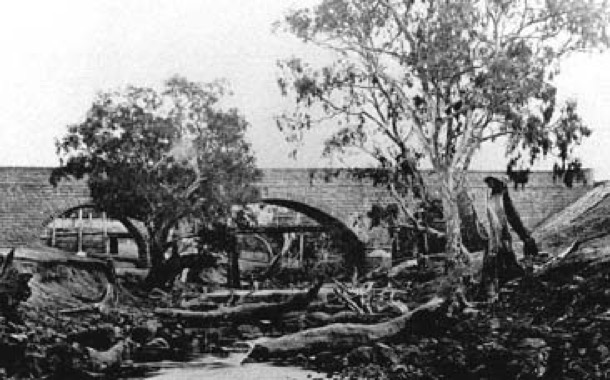
Barwon Bridge then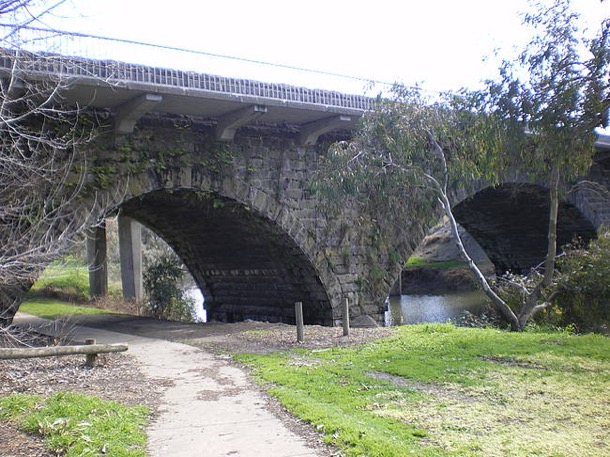
Barwon Bridge now
We don’t know whether Mr and Mrs Coates planned to do this job and then return to England, but they would have found a thriving, wealthy colony. Gold had been discovered in central Victoria just ten years earlier.
DOW, ARRIVED VICTORIA 1860s
Dow was a German farmer who arrived in Australia in the 1860s. He married a fifteen year old girl, of whom we know very little. Wandong is 70 Kilometres north of Melbourne. In the years the Dows lived there there was a thriving timber industry and some gold mining. By 1880 there was a railway line from Melbourne.
HOLM, ARRIVED ADELAIDE 1872
Roger Holm: this one is our great grandparent, a baker, who himself arrived in Australia from Denmark via England in 1872.
Roger had been born in a part of Denmark called Schleswig-Holstein, that had been disputed territory for centuries. At the time when he was a child, Germany did not yet exist. It was still a whole lot of little countries. When Roger was twelve, Otto Von Bismarck’s army invaded Schleswig-Holstein.
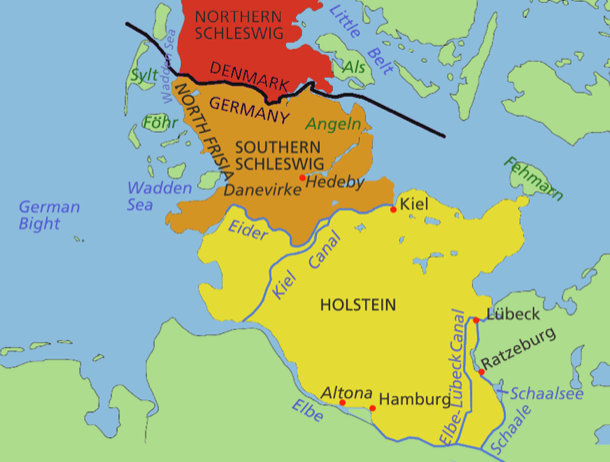
Map of Schleswig-Holstein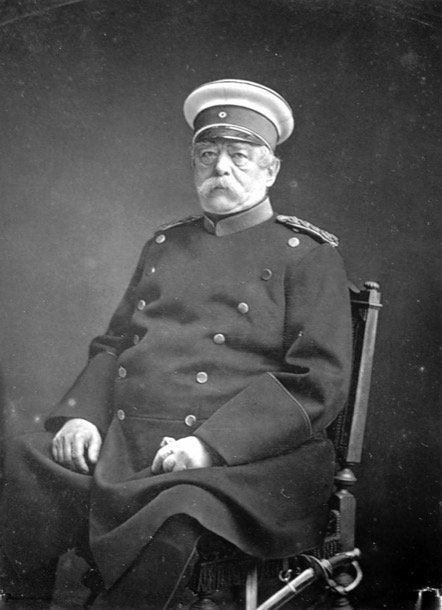
Otto Von Bismarck
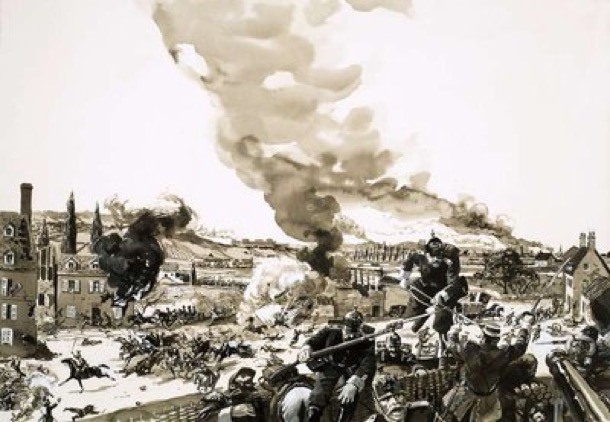
Painting: Bismarck Wresting Schleswig Holstein From The Danes
BELL, ARRIVED VICTORIA 1850s
David and Martha Bell was an Irish flax farmer, who arrived in Australia with his wife Martha (born Martha Elvidge) in the 1850s. Belfast was a prosperous modern city at that time.
The area had become a specialist for farming and processing flax, which was woven into linen, used among other things for ships’ sails.
Twelfth Birthday Letters to Alice
These two letters were written to our mother Alice on her 12th birthday. Alice was staying with her grandparents , Roger and Martha Holm at their house in Boronia Street Surrey Hills. By the way, the house is still there, but more of that later in another story. Living with Roger and Martha was another of their daughters, Bertha or Auntie Bert, unmarried and with a flourishing dressmaking business in the front room of the house. Later she moved the business to Camberwell at the Junction. These letters were written by Alice's father Alfred, usually known as Alf, and her mother Alfreda or Freda. The letters reveal two very different personalities that both had a powerful and enduring influence on their young daughter. Our joint memories of the two authors of the letters are of two very different individuals.
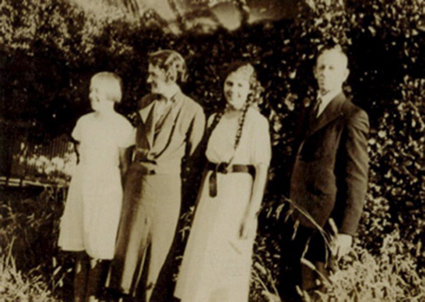
From left Alice, Freda, Marge, Alf
ALF'S LETTER
CROYDON
23.9.35
My Dear Baby,
Although you will be 12 years old tomorrow you are still my baby, and you always will be. Your old Pop wishes you many happy returns of the day, and hopes that the sun will be shining brightly, so that you will be able to enjoy yourself.
I am sitting beside the stove writing this, although the night is not cold; but you know how I love the fire. (Mummy has just burst in on my meditations with a dose of Cascara.) (herbal laxative)
The Kettle sings upon the stove,
It sings a lovely song to me.
It sings a song I dearly love-
“I’m boiling for your cup of tea”
(Auntie will appreciate that verse)
The chooks have settled down to rest
Their daily duty nobly done.
Each one has given of her best,
And Mummy loves them, every one.
(That verse will appeal to Nanna)
The cats are sleeping in the straw,
Their stomachs full of meat and mice.
They sleep so sound - I heard them snore.
Their beds are comfy, soft, and nice.
The house is quiet. All noise is stilled.
Outside the night is calm and clear.
My cup of love has now been filled.
I drink your health, my Baby dear.
(A. J. Coates Poet)
Don’t stay away too long. I can’t spare you. I haven’t any anybody to get in the gun. The cow got out of the paddock, and I told her she was in the gun; but she didn’t take any notice of me. So what’s the good of that.
Good-night, Snowy-Bob, with your
Dad’s best love.
X x x x x x x x
Give my love to everybody.
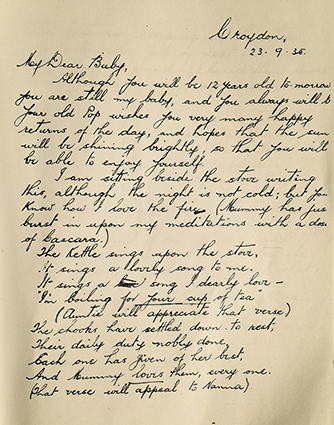
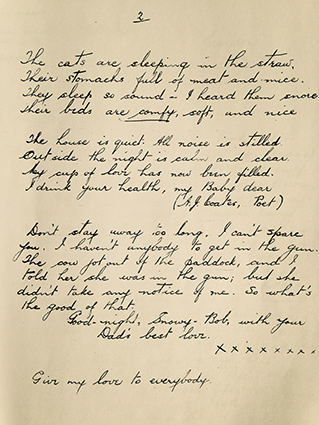
ALFREDA'S LETTER
CROYDON
23.9.35
My dear little Girl,
I cannot find a pen but I must write and wish you many happy returns of your birthday even if I only use pencil. It is rather superfluous for mothers to wish their children that formal wish, isn’t it dear? Because every day we are doing things to make our little children well and happy so that they will have many happy returns.
When you are away from me I realize how much every minute of the day is spent in doing this and how much I love my little baby girl. My mother and father did that for me and some day you will do that for your little children and then you will realise what a big love mothers and fathers have for their children It is the love that makes life worth living - the giving love, or shall I call it: the love that forgets self. That is the kind of love that makes the giver happiest.
It is one of the big true things that Jesus taught. I think the best I can wish for you on your 12th birthday is that you will realize more and more as the years go on just how true and real are all the things that Jesus taught, and dear you can only get to know by letting God teach you, asking Him to teach you.
What a funny old letter to be writing to you today dear.
I wonder if it is because I realize you are growing up. You will be finding things out yourself more, in other words “growing up”. I think you started growing when you were a baby but I don’t just mean that kind of growing up.
Well dear we have had quite a gay weekend, the pictures were beautiful. I was wishing you and Marj were there. Tell Auntie to ring Dad if she has any other plans for Wednesday.
Good-bye my dear little one.
All my love is going to be sent to you at 12 o’clock tomorrow by thought waves.
Do you know what I mean? I will think of you at 12 o’clock and you think of me and that that will mean a birthday kiss and all my love.
Mother
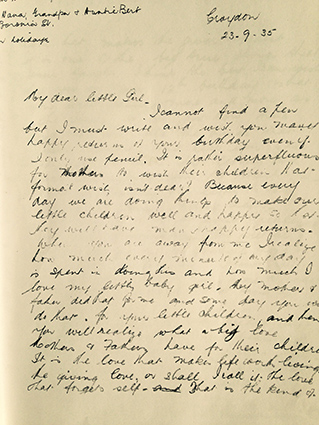
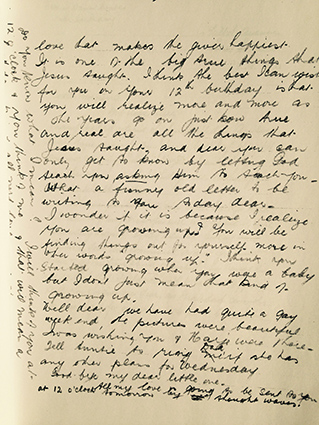
Here are Martha and Roger with Alice and Marge and other younger grandchildren in the Boronia Street Garden
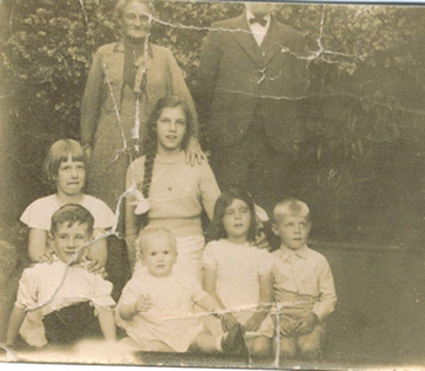
Memories of Alf
“A J Coates, poet.” That dry humour is so much as I remember my papa. My strongest memories of him are from his time living in the flat attached to our house in the nineteen sixties. By that time his red hair was greying and although he was still tall, he was a bit stooped.
“What do an old spud and a man watching a football match have in common? They’re both “specked taters”. His jokes were all like that.
But his sense of humour was strangely coupled with an enduring air of melancholy. He had several “nervous breakdowns” in his life. Nowadays these would be called bouts of clinical depression.
Alf had been a very gifted student and had spent his very early working life as a teacher. The precision of his letter writing is evident in the setting out and punctuation.
We remember his collection of classics and poetry books and often he would lend them to us. He loved reading, including poetry. The “bush poets” Henry Lawson and Banjo Patterson’s best work was behind them by the time Alf was at school, but their work, and that of other Australian poets were very strongly part of the everyday curriculum. This gives a context to Alf writing a mock bush poem as he did in his letter, and signing it like that. But that wry, self deprecating humour is there too.
The other aspect of his personality that shines through is his gentle warmth. This was a time when Australian men were loathe to express such softness. Our mother told us about how he struggled with his own sense of masculinity. Although he worked in timber yards, his work was behind the hardware shop desk. He was ashamed of this. His insistence on only ever wearing black socks was seen as symbolic of his fear of being seen as a sissy. And yet here is this loving, expressive father writing to his daughter, apparently at ease with openly expressing his love.
Memories of Alfreda
Alfreda was also tall. I remember her as a rather elegant, formal figure, clad in beautifully tailored clothes, no doubt made for her by her clever sister. She had very long hair always worn in a loose bun. I do not remember her ever being without her stockings and high heeled lace-up black shoes. The two times I remember staying with Nana and Papa I can remember watching Nana in her dressing gown, sitting at her dressing table, brushing her hair and loosely plaiting it for the night. She was quite a remote figure, not one for hugs and cuddles. However, my memories are of warmth and affection towards her two daughters and her husband.
Neither Margaret or I have any memories of her obviously very strong religious beliefs, that seem to have been very much part of her everyday life and thoughts. We only learnt of these through reading her letters. It would be gratifying to Alfreda that her daughter Alice did indeed see “just how true are all the things that Jesus taught". In fact, in the latter part of her life, Alice’s interest in theology provided her with both intellectual stimulation and solace. I suspect mother and daughter were very alike.
How we remember Alf and Alfreda, in their seventies:
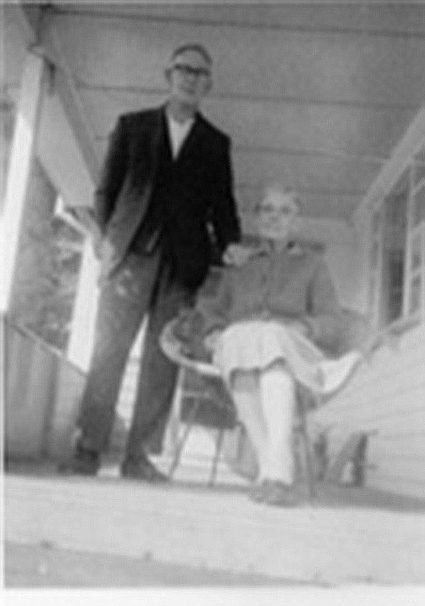
Historical, Social and Geographical context
Main Street Croydon, 1930s
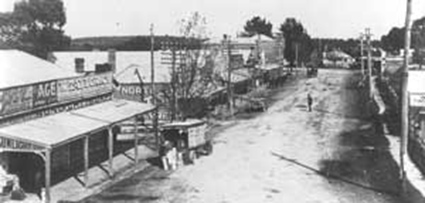
At the time of these letters, the Coates family lived in Hewish Road, Croydon, close to where the Croydon swimming pool is today. The Great Depression of the nineteen-thirties was at its height. Alf never lost his job at the Croydon Timber Yards, even though many men did. The family kept chickens, whose eggs they sold, and a cow and had a large vegetable garden.
Alice and Marge remembered the desperate men who would come to the house for a chance to do some odd jobs around the house. The Coates family were not well off by any means, but they were grateful for what they had and shared it generously with others.
Politically the nineteen-thirties was a time of turmoil and change. Thirty percent of the Australian workforce was unemployed, and this was reflected across the western world. Economic theories about how to deal with the crisis ranged from the Keynesian “spend your way out” adopted by America, to severe austerity and cuts in Government spending practised in Australia. Political “isms” and experimentations like Communism and Nazism were being explored and discussed around kitchen tables everywhere, and nowhere more ardently than at the Coates’. Alice remembered such pearls of wisdom from her mother as “you can’t educate for goodness and you can’t legislate for goodness”.
The young Alice drank in all this talk and even as a twelve year old, when these letters were written, she was developing the philosophies that would engage her for all of her life.
Croydon, a busy suburb nowadays, was a country town, connected by rail to the Eastern suburbs and the city. In 1935 Alice would have been going to Mont Albert Central School (until Year 8) and Marge to the city based Melbourne Girls' High School, soon to be renamed McRobertson Girls' High School. They travelled on the steam train that went as far as Healesville and Warburton. Incredibly this was the closest school for them that went past Year 10. Expensive school fees were a stretch for the family, but education was valued very highly.

